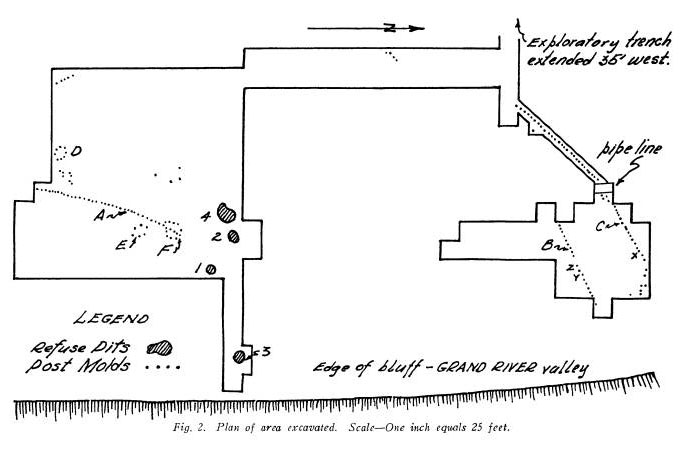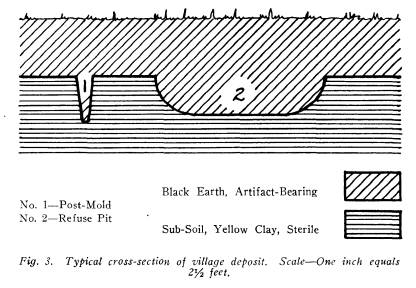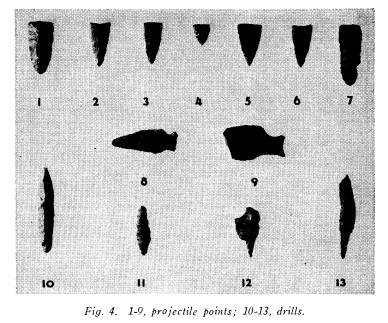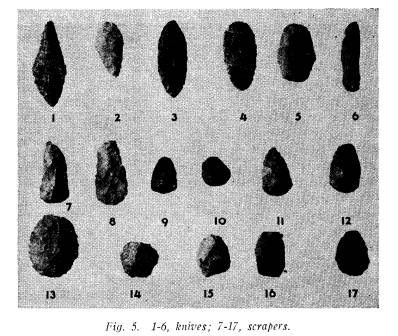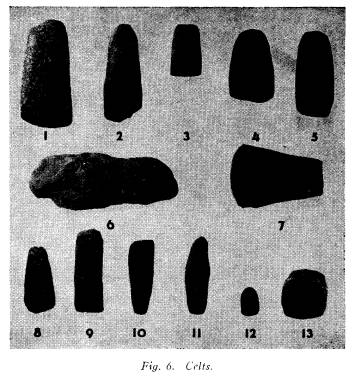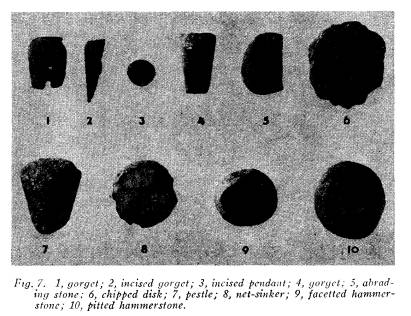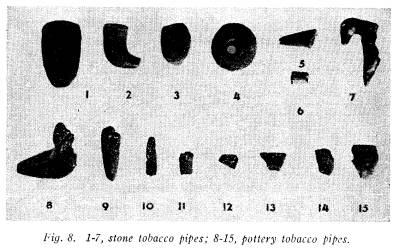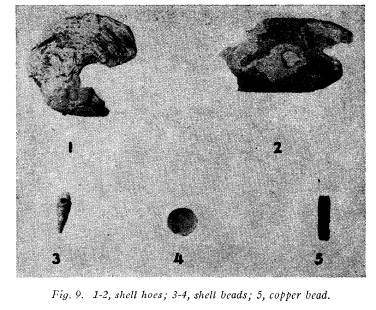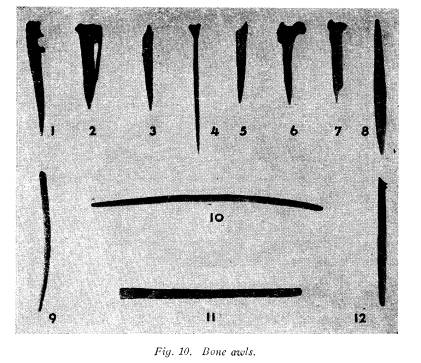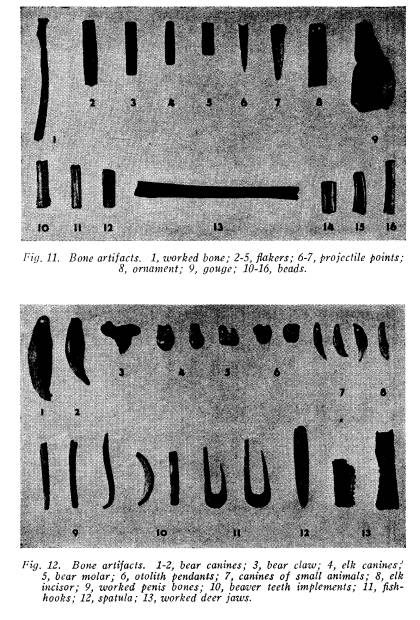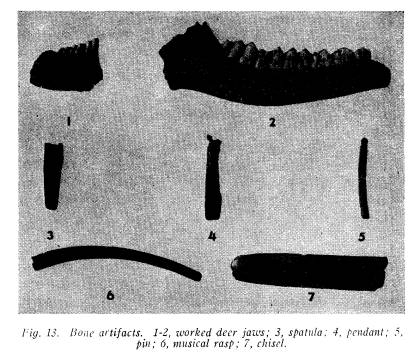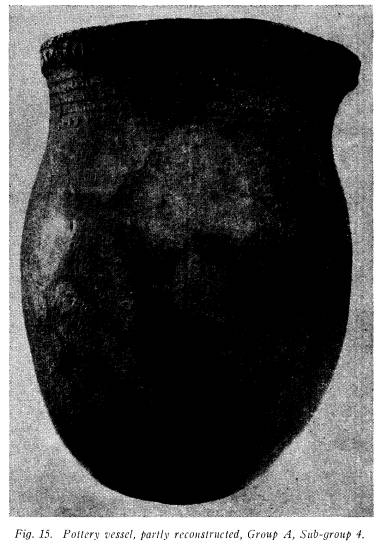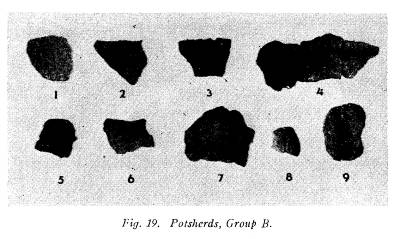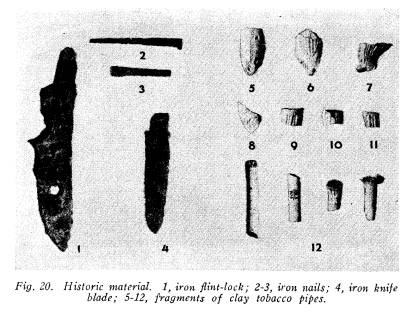Ohio History Journal
THE FAIRPORT HARBOR VILLAGE SITE
BY RICHARD G. MORGAN AND H.
HOLMES ELLIS
PREFACE
The Indian village site described in
this report was explored
by the Department of Archaeology of the
Ohio State Museum
in cooperation with the Harding High
School of Fairport Harbor,
Ohio. The existence of the site was
brought to the attention of
the Museum by Mr. Elijah H. Brown,
principal of the high school.
Through the efforts of Mr. Brown,
permission was secured to
excavate the site from Mr. B. H. Snyder,
representing the Harbor
Land Company, owner of the property. The
specimens found in
the site were divided between the Ohio
State Museum and the
Harding High School.
Excavating was carried on at the site
from August 10 to
September 3, 1937, under the direction
of Mr. Richard G. Mor-
gan, Curator of Archaeology, Ohio State
Museum, and Mr.
Robert M. Goslin, Field Assistant. The field force consisted
of Mr. Elijah Brown and the following
members, most of whom
were students at the local high school:
George Snyder, John
Toth, Kayo Saarela, John Simko, Rudolph
Henninger, Steve
Vegso and Steve Ondo.
The writers wish to thank Mr. Brown and
Mr. Snyder for
their fine cooperation in making the
work possible and to acknowl-
edge the hospitality and assistance of
the people of Fairport
Harbor and vicinity.
DESCRIPTION OF SITE
The Fairport Harbor Village Site is
located in Painesville
Township, Lake County, Ohio, on the
Grand River (Fig. 1).
The site is situated on the east side of
East Street immediately
south of the railroad crossing and lies
between the street and
the edge of the river bluff. It is about
three-quarters of a mile
(3)
|
4 OHIO ARCHAEOLOGICAL AND HISTORICAL QUARTERLY |
|
|
|
from Lake Erie and overlooks the valley of the Grand River. The river at this place flows in a southeastern direction and is situated at some distance from the edge of the bluff. At the present time the flood-plain between the river and the edge of the bluff is used by the Diamond Alkali Company as a settling basin for waste material. The site, which covers an area of somewhat over an acre. |
FAIRPORT HARBOR VILLAGE SITE 5
extends on the east to the edge of the
river bluff which is grad-
ually being eroded away by caving. It is
apparent that a portion
of the area has been lost by erosion,
although it is not possible
to estimate how much farther east the
village debris once ex-
tended. According to local residents,
the site has not beer
farmed within recent years but the
probabilities are that it had
been cultivated in the past. At the time
of our preliminary ex-
amination the area was covered with
grass, high weeds and
bushes. Only one tree was present on the
site and, since it stood
at the edge of the bluff, it was not
disturbed. The surface of
the site was approximately level except
for pits dug by persons
seeking Indian artifacts. Several small
collections from the site
are in the hands of local individuals
and some of these have been
loaned to the high school. It should be
noted that some of this
material has been included in the
artifact description in this
report, especially specimens which were
not duplicated by ob-
jects recovered during the excavations.
Complete excavation of the site was not
possible due to
lack of sufficient funds. Enough
material was recovered, how-
ever, to be considered culturally representative
of its occupants.
Nineteen hundred and fifty artifacts,
eleven thousand, six hun-
dred and three potsherds and hundreds of
animal and bird bones
were found in the deposit. Further
excavation, however, might
have thrown more light upon the post-mold
patterns which were
encountered during the work. As the site
is gradually being
destroyed by erosion as well as digging
by collectors and is in
danger of being encroached upon by a
modern refuse dump, it
is fortunate that even a limited portion
of the area was carefully
excavated.
STRUCTURAL FEATURES
The area excavated (5,1O6 square feet)
was staked out in
five-foot squares for mapping purposes
and all features were
recorded on the ground plan (Fig. 2). Artifacts were
recorded
horizontally by five-foot square
designations and vertically by
arbitrary six-inch levels. The record by
levels revealed no sig-
nificant differences in either frequency
or type of material found.
|
FAIRPORT HARBOR VILLAGE SITE 7 Excavation showed that the artifact-bearing deposits on the site consisted of a layer of black earth which extended from the surface down to the undisturbed sub-soil (Fig. 3). The yellowish clay of the sub-soil contrasted sharply with the overlying black |
|
|
|
soil. The black earth varied in depth from about ten inches to eighteen inches with an average depth of around fourteen inches. Intermixed with it, from top to bottom of the deposit, were artifacts, potsherds, fire-cracked stones, ashes, charcoal, flint chips and spalls, and animal, bird and fish bones. With the exception of one large glacial boulder about three feet across, the objects con- tained in the black earth could be attributed almost entirely to human occupation. The blackness of the earth is typical of village sites found along the southern shore of Lake Erie. It was caused by the continued occupation of a restricted area with the resultant accumulation of organic material of both animal and vegetal origin. It is interesting to note that gardeners and nursery men often |
8
OHIO ARCHAEOLOGICAL AND HISTORICAL
QUARTERLY
obtain earth from Indian village sites
in the region to enrich their
garden tracts. This practice, while
sometimes leading to the dis-
covery of unknown sites, also hastens
their destruction.
Layers of ashes and burned earth were
encountered at sev-
eral places in the deposit of black
earth. One of these, indicated
by X on the ground-plan (Fig. 2), was
roughly oval in form,
two feet across, three inches in
thickness, and was located six
inches beneath the surface. A second (Y
on the ground-plan),
similar to the first in extent, was
twelve inches beneath the sur-
face. A third burned area (Z on the
ground-plan) was twelve
inches beneath the surface and covered
an area five feet in length
and one foot in width. While the first
two features may be
fire-places, the third must be noted as
due to a fire of unknown
purpose.
At several places in the black deposit
thin layers of sterile
yellow clay were present with black
earth above and below them.
This yellow clay was the same in
composition as the sub-soil
and may have been dug up and scattered
around when post-holes
and pits were dug into the underlying
deposit. Nothing indicat-
ing human activity was found in the
sub-soil and there was a
sharp division line between it and the
black earth above. It
should be mentioned in this connection,
however, that post-molds
and pits extended down into the yellow
sub-soil.
REFUSE PITS
Only four pits were found at this site
and they were all small
and shallow (see ground-plan Fig. 2).
They were outlined as
oval black areas at the level of the
yellow sub-soil.
Pit No. I: This pit was roughly circular
with a top diam-
eter of two feet and three inches. It
was shallow and bowl-
shaped, extending only six inches into
the underlying clay. No
artifacts were found in this pit which
contained only tightly packed
black earth.
Pit No. 2: Pit No. 2 was irregularly
oval in form with a
long axis of four and one-half feet and
a short axis of four feet.
It extended a foot down into the
sub-soil with a diameter at the
bottom of about three and one-half feet.
It was filled with black
FAIRPORT HARBOR VILLAGE SITE 9
earth intermingled with artifacts,
potsherds, animal bones, and
fire-cracked stones. Most of the stones
were in the bottom of
the pit. The sherds found in this pit
belonged to one pottery
vessel which was partially restored
(Fig. 15). The following
artifacts were taken from this pit:
eight projectile points, four
scrapers, one hammerstone, one
net-sinker, two bone beads, one
bone awl, and one piece of worked bone.
Pit No. 3: The outlines of this pit were
recognized four
inches above the level of the sub-soil.
It was circular in form
with a diameter at the top of three feet
and extended down into
the yellow clay eight inches. Mixed with
the black earth fill of
this pit were many fragments of charcoal
and charred twigs, and
fire-cracked stones covered its
basin-shaped bottom. There were
no artifacts in it. The evidence seems
to indicate that this pit
may have been used for cooking purposes.
Pit No. 4: This irregular pit was five
and one-half feet long
and four feet wide and extended down
into the sub-soil ten inches.
It contained black earth mixed with
ashes, charcoal, animal and
fish bones, several pieces of pottery,
fire-cracked stones, one ham-
merstone and one projectile point.
POST-MOLDS
Numerous post-molds were found during
the course of the
excavation, all of which were plotted on
the ground-plan (Fig. 2).
They showed up as circular black areas
on the surface of the
yellow sub-soil. Some of them may have
extended up into the
black earth but this could not be
determined due to the color and
nature of the soil. Three distinct rows
or linear patterns were
uncovered which are indicated by the
letters A, B and C on the
ground-plan.
Row A: The post-molds of Row A
were traced for a distance
of approximately forty feet in a
slightly curving line. They were
spaced rather irregularly, varying from
about six inches to one
foot and three inches from center to
center, with the majority
being about eight inches apart. The
molds petered out at the
northeastern end of the row but extended
to the limit of the
excavated area on the southwest.
10
OHIO ARCHAEOLOGICAL AND HISTORICAL QUARTERLY
Row B: The post-molds of this row
extended for a distance
of twenty-five feet in almost a straight
line. They varied in their
spacing from eight inches to two feet
and three inches, most of
them being about twelve inches apart
from center to center.
Row C: This row extended for
fifty-four feet in a slightly
curving line from northeast to
southwest, being interrupted at
only one place by a pipe-line. Like the
other two rows, the spac-
ing of the molds varied considerably
with most of them measur-
ing about a foot from center to center.
The post-molds varied widely in their
diameter at the level
of the top of the sub-soil. Their
diameters ranged from about
three inches to about five and one-half
inches with the majority
being around four and one-half inches.
Cross-sections showed
that some of the post-molds extended
down into the sub-soil as
much as fourteen inches and that their
diameter decreased at the
bottom to two inches. This tapering of
the post-molds would
seem to indicate that the posts which
occupied them were also
tapered. There is no way of knowing how
high the posts were.
These rows would seem to indicate
enclosures which perhaps
surrounded the village area. In general,
their direction is north-
east-southwest and it should be noted
that Row B is nearly paral-
lel to Row C. They may have
extended in a semi-circle with the
ends of the rows terminating at the
river bluff. At several points
there were smaller post-molds between
two larger ones and it
may be that there were branches
interlaced between the posts.
There is no way of knowing whether they
were high stockades or
palisades. The separate rows may
represent different periods
of occupation, not meaning, however,
that any great length of
time elapsed between their construction.
In addition to the linear patterns of
post-molds there were
three circular or oval patterns
indicated by D, E and F on the
ground-plan (Fig. 2). The pattern at
D was three and one-half
feet in diameter and almost circular in
form. The post-molds
were somewhat smaller than those of the
rows and were spaced
about nine inches apart from center to
center although there was
considerable variation. The pattern at E
was oval in outline
FAIRPORT HARBOR VILLAGE SITE II
with a long axis of two feet and three
inches and a short axis
of one foot and nine inches. The pattern
at F was somewhat
confusing as it was cut by Row A,
but an oval structure five
feet long and three and one-half feet
wide seemed to be indicated.
The function of these small oval
structures is unknown.
ARTIFACTS
STONE ARTIFACTS
Projectile Points: Six hundred and nine flint projectile
points were found at the site. All of
these are of the small trian-
gular type (Fig. 4, Nos. 1-7) except for
two which are notched
(Fig. 4, Nos. 8-9). Two hundred and
sixty of the triangular
points were complete and the remainder
were fragmentary. The
triangular points range in length from
17 mm. to 45 mm., in width
from 10 mm. to 24 mm., and in
thickness from 3 mm. to 14 mm.
Their mean length is 27.4 mm., mean
width 16.2 mm. and mean
thickness 5.9 mm. They are more or less
uniform in shape with
straight or slightly convex sides, and
with either straight (133),
concave (85), or convex (42) bases.
One of the notched points is complete
while the other is
broken. The complete specimen (Fig. 4,
No. 8) is of the side-
notched type and is 50 mm. in length,
19.5 mm. in width and
9.5 mm. in thickness. The other specimen
(Fig. 4, No. 9) has
a shallow notch and is 28 mm. in width
and 9 mm. in thickness.
Drills: The nineteen flint drills may be
divided into two
general types, straight and
expanded-base. The twelve straight
drills (Fig. 4, Nos. 10-11) range in
length from 23 mm. to 67 mm.,
in width from 10.5 mm. to 12 mm., and in
thickness from 4 mm.
to 13 mm.; the average specimen being 37
mm. long, 11 mm. wide
and 7 mm. thick.
The seven expanded-base drills (Fig. 4,
Nos. 12-13) range
in length from 26 mm. to 67 mm., in
width from 13 mm. to
18 mm. and in thickness from 3 mm. to 9
mm. They average 36.2
mm. in length, 15 mm. in width and 6.5
mm. in thickness.
Knives: Twenty-four flint knives were
found representing
several different types. Type I consists of
eleven specimens which
|
12 OHIO ARCHAEOLOGICAL AND HISTORICAL QUARTERLY |
|
|
|
are pointed at both ends and have a distinct shoulder slightly below the center (Fig. 5, No. 1). The average length of this type is 55.5 mm., width 22.8 mm. and thickness 6.5 mm. Type 2 is made up of six specimens which are pointed at one end and rounded at the other with a distinct shoulder as in Type I (Fig. 5, No. 2). They average 47.4 mm. in length, 20.8 mm. in width, and 6.4 mm. in thickness. Type 3 consists of two blades pointed at both ends but not shouldered (Fig. 5, No. 3). This type averages 60.2 mm. in length, 21.7 mm. in width, and 4.5 mm. in thickness. Type 4 includes two blades which are rounded at both ends (Fig. 5, No. 4). These specimens average 58 mm. in length, 28.5 mm. in width, and 6.5 mm. in thickness. One specimen, which is rounded at both ends, may have been originally of the pointed, shouldered type which was broken and then rechipped. It measures 42 mm. in length, 27 mm. in width, and 4 mm. in thickness. A broken knife blade with shallow notches on the sides was also found. A single flake knife was |
|
FAIRPORT HARBOR VILLAGE SITE 13 found in the site (Fig. 5, No. 6). It is 50 mm. long, 13.5 mm. wide, and 5.5 mm. thick. Scrapers: The one hundred and sixty-one flint scrapers found at this site may be divided into four distinct types: end, round, rectangular and ovoid. |
|
|
|
One hundred and fourteen fall into the end-scraper group (Fig. 5, Nos. 7-12). These implements are pointed at the base, have a ridge on one or both sides, and a somewhat bevelled cutting edge. While eighty-five of these end scrapers have ridges on both sides and twenty-nine are flattened on one side, it seems apparent that this variation was due to difficulties encountered in the chipping of the specimens rather than to intentional shaping. The end scrapers have an average length of 29.9 mm., a width of 20.4 mm. and a thickness of 7.5 mm. The thirty-two round scrapers (Fig. 5, Nos. 13-15) are very |
14 OHIO ARCHAEOLOGICAL AND
HISTORICAL QUARTERLY
roughly fashioned, chipped on all edges,
and are more or less cir-
cular in shape. The mean length of these
specimens is 34 mm.,
width 26.4 mm., and thickness 12.6 mm.
The eleven rectangular scrapers (Fig. 5,
No. 16) are chipped
on all edges and on both sides. They
average 30.6 mm. in length,
23.2 mm.
in width, and 9.1 mm. in thickness.
The ovoid scrapers (Fig. 5, No. 17) are
elongate-oval in
form, chipped on both sides, and on all
edges. The four speci-
mens in this category average 31 mm. in
length, 16.7 mm. in
width, and 8.6 mm. in thickness.
Miscellaneous Flint Objects: There are
two oval-shaped
"turtle backs" which are
roughly chipped and may represent un-
finished objects. One measures 109.9 mm. in length,
49 mm. in
width, and 32 mm. in thickness; the other is 79 mm. in length,
37 mm. in width, and 29.5 mm. in thickness.
In addition to the specific implement
forms which have been
described, six hundred and twenty-six
flakes, spalls, broken
nodules and slightly worked fragments of
flint were collected
during the course of the work.
Source of Flint: The flint used by the
occupants of the
site for their artifacts is of one
general type. It ranges in color
from a brownish to a bluish gray and on
the whole is of poor
quality. It evidently was secured in the
form of water-worn
pebbles from neighboring stream beds.
Celts:
Fourteen pecked and polished diorite celts were
found, seven of them fragmentary (Fig.
6, Nos. 1-4). The im-
plements are well-made and have slightly
rounded sides, rounded
polls and bevelled bits. The complete
specimens range in length
from 63 mm. to 153 mm., in width at the
polls from 30 mm. to
48 mm., in width at the bits from 35 mm.
to 62 mm., and in
thickness from 15 mm. to 35 mm. They
averaged 102.7 mm.
in length, 25.3 mm. in thickness, 35.2
mm. in width at the poll,
and 47.7 mm. in width at the bit.
A single specimen, which might be termed
an adze, was
found (Fig. 6, No. 5). It is made of
ground and polished
chlorite schist. The bit end is convex
on one side and slightly
|
FAIRPORT HARBOR VILLAGE SITE 15 |
|
|
|
concave on the other. It measures 103 mm. in length, 38 mm. in width at the bit, 30 mm. in width at the poll, and 18.5 mm. in thickness. Nine roughly chipped celts made of brownish slate occurred at the site, seven of which were complete and two broken (Fig. 6, Nos. 6-7). The bits were sharpened by grinding and the polls are rounded except for one specimen which has a square poll (Fig. 6, No. 7). The greatest width is usually at the bit and the straight sides taper toward the poll. These implements are large, ranging from 85 mm. to 176 mm. in length, 37 mm. to 75.5 mm. in width at the bit, 23 mm. to 55 mm. in width at the poll, and 13 mm. to 32.5 mm. in thickness, the average specimen being 131.4 mm. in length, 42.5 mm. in width at the poll, 58.9 |
16
OHIO ARCHAEOLOGICAL AND HISTORICAL
QUARTERLY
mm. in width at the bit, and 20.7 mm. in thickness. In addition,
there are two roughly chipped slate
artifacts which appear to be
unfinished celts, as they are without
cutting edges.
Seven crudely chipped diorite celts were
found (Fig. 6,
No. 8). They are polished and have
tapering sides. One speci-
men is slightly grooved on both sides.
They average 119 mm.
in length, 53.3 mm. in width and 20.4
mm. in thickness.
In contrast to the tapering-sided celts
there are five small,
straight-sided celts, four of slate
(Fig. 6, No. 9) and one of
pecked and polished diorite. The slate
specimens were made
from flat, water-worn stones by grinding
one end into a cutting
edge. Although compartively narrow, they
do not taper at the
bit as do those which have been
described as chisels. The two
whole specimens average 83.3 mm. in
length, 31.2 mm. in width,
and 13 mm. in thickness.
Two chisels were found, one of black
slate (Fig. 6, No. 10)
worked mainly at the bit, the other
(Fig. 6, No. II) of pecked
and partly polished diorite. Both
specimens taper toward the
bit.
A small celt-like object (Fig. 6, No. 12) 34 mm. long, 21 mm.
wide and 7 mm. thick, made from a flat
sandstone pebble, was
found. The bit is the only portion
worked and it has a bevelled
cutting edge.
An object was found which resembles the
bit end of a
thick celt cut off squarely across the
middle (Fig. 6, No. 13). A
hole II mm. in diameter and 6 mm. deep
was bored in the center
of the cut end. The bit is bevelled, as
are the sides, thus form-
ing a ridge on three sides of the
specimen. This artifact, which
is made of limestone, is 60 mm. in
length, 53 mm. in width, and
30 mm. in thickness.
In addition, there are four specimens, roughly
blocked out,
which apparently represent unfinished
celts. Two are of slate,
one of mica schist, and one of
limestone.
Hammerstones: Sixty-three pitted
hammerstones were
found at this site (Fig. 7, No. 10).
They were made from
water-worn stones of various materials,
and, hence, vary con-
|
FAIRPORT HARBOR VILLAGE SITE 17 siderably in size and shape. The majority of them are pitted on both sides, but some are pitted on one side only, while others have several pits on a side. They average 96.5 mm. in length, 74.6 mm. in width, and 44 mm. in thickness. |
|
|
|
Fifteen faceted hammerstones made of diorite are present in the collection (Fig. 7, No. 9). These artifacts were originally water-worn stones of a more or less uniform size to fit the hand. They have been ground down around the edges to form a bevelled ridge completely encircling the object. The portions of the sur- face which have not been modified form flat facets which are pol- ished. The polished effect is evidently partly natural and partly due to continued use. They average 63.3 mm. in length, 59 mm. in width, and 49 mm. in thickness. In addition, there are two hammerstones which show no evi- dence of pitting but are merely water-worn stones that were used as hammers. |
18
OHIO ARCHAEOLOGICAL AND HISTORICAL QUARTERLY
"Net-sinkers": Nineteen flat
water-worn stones, largely
unworked except for two rough notches on
opposite sides, were
found in the site (Fig. 7, No. 8). These
forms have been called
"net-sinkers" by some writers.
Slate was the most commonly
used material for them, however, three
are of sandstone, three
of limestone and one of a granitic
material. The stones are of
more or less the same general size,
averaging 77.5 mm. in length,
66 mm. in width, and 17.5 mm. in
thickness.
Pestles: Two pestles made of igneous
rock were found
(Fig. 7, No. 7). One is 76 mm. in length
and 50 mm. by 55 mm.
in diameter at the base; the other is 96
mm. in length and 60 mm.
in diameter at the base. They are both
roughly made and are not
polished.
Stone Disks: Two micaceous sandstone
disks, roughly
chipped, were recovered (Fig. 7, No. 6).
One is 85 mm. by 77
mm. in diameter and 5 mm. in thickness;
the other is 65 mm. by
59 mm. in diameter and 10.5 mm. in
thickness.
Abrading Stones: There are two abrading
stones made of
fine sandstone which have grooves on
both sides (Fig. 7, No. 5).
The stones are irregularly shaped; the
greatest diameter of one
being 77 mm., of the other 65 mm. and
both are 14 mm. in thick-
ness.
Tobacco Pipes: Seven stone tobacco
pipes, most of them
fragmentary, were found in the site.
Several different types are
represented among them. One is a black
slate pipe (Fig. 8, No. I)
of the keeled type similar in form to
bird-effigy pipes found in
New York.1 The front of this pipe
evidently had a perforated
projection at one time which was broken
off and the broken
surface refinished. The dimensions of
this pipe are as follows:
height 65 mm., width at top of bowl 33
mm., width at base 16 mm.,
diameter of bowl 15 mm., and diameter of
stem-hole 10.5 mm.
There is a broken effigy pipe of the
keeled type made of a
brownish-black slate (Fig. 8, No. 7). It
is 57 mm. in height.
The stem portion is missing as well as
part of the bowl. Project-
ing forward from the bowl is a
representation of a bird's head
1 A. C. Parker, "The Archaeological
History of New York," New York State
Museum Bulletin (Albany, N. Y.)
nos. 235-6, part I (1922), pl. 48.
|
FAIRPORT HARBOR VILLAGE SITE with the eyes indicated by holes. The mouth is represented by incised lines and there are scratches or cutting marks on various portions of the surface. This specimen is similar to pipes found at the Reeve Village Site.2 A fragment of a slate effigy pipe was found which evidently represents the bill of a bird (Fig. 8, No. 5). It retains a small portion of the bowl. Although this may be a part of a keeled effigy pipe similar to the one previously described, it may corre- spond to the one figured by West.3 |
|
|
|
A plain elbow pipe of flint clay was found (Fig. 8, No. 2). It is highly polished but has numerous scratch marks on the stem and tiny incised lines around the lip of the bowl. The bowl, which is broken on one side, is 42 mm. high and 23.5 mm, in diameter on the outside; the inside diameter of the bowl is 15.5 mm.; and the stem is 17 mm. in length and has an opening 4 mm. in diameter. One pipe is of the conoidal type and is made of limestone (Fig. 8, No. 3). Its dimensions are as follows: height 37.5 mm., 2 E. F. Greenman, "Excavation of the Reeve Village Site, Lake County, Ohio," Ohio State Archaeological and Historical Quarterly (Columbus), XLIV (1935), fig. 26. 3 G. A. West, "Tobacco, Pipes and Smoking Cutsoms of the American Indians." Public Museum of the City of Milwaukee, Bulletin (Milwaukee, Wisconsin), XVII (1934), pl. 40, no. 5. |
20
OHIO ARCHAEOLOGICAL AND HISTORICAL QUARTERLY
diameter at top of bowl 17.5 mm.,
diameter of bowl opening 15
mm., and diameter of stem-hole about 9
mm.
The bowl portion of a pipe made from
calcite was recovered
(Fig. 8, No. 4). The bowl has a slightly
flaring lip with an out-
side diameter of 47 mm. The diameter of
the bowl opening is
14 mm. The top of the bowl is polished
but the rest of the sur-
face is covered with rough peck marks.
A small cut fragment of pipe stem,
measuring 17 mm. in
length and 11.5 mm. in diameter, was
found (Fig. 8, No. 6). It
is cut squarely on one end, while the
other, evidently the bit,
is somewhat rounded. It is possible that
this broken pipe stem
was reworked and used as a bead.
In addition, a large rough block of
limestone was found which
was partly worked as if intended for a
pipe.
Ornaments: The only complete stone
ornament found was a
pendant made from a flat,
reddish-colored pebble (Fig. 7, No. 3).
Near one margin there is a small
perforation which was drilled
from both sides. On one side there are
five finely incised lines
fanning out from a point just below the
hole to the margin of the
object. The specimen is nearly circular,
measuring 28 mm. from
top to bottom, 29.5 mm. across,
and 10 mm. in thickness.
A fragment of a black slate gorget is
shown in Fig. 7, No. 2.
It is decorated on both surfaces by
zig-zag and other short parallel
incised lines. The edges are rounded and
the specimen shows tool
marks from grinding operations. It is 65
mm. in length and 6 mm.
in thickness.
Another broken gorget is illustrated by
Fig. 7, No. 4. This
object, which is made of banded slate,
has tapering sides. It is
62.5 mm. in length and 14 mm. in
thickness.
There is a gorget or pendant made of
black slate which has
two perforations (Fig. 7, No. 1). One
of the holes, which is at
the broken end, is only partly
represented. When this end was
broken or worn through, a second hole
was drilled to take the
place of the original hole. The holes
were drilled from one side
only. This specimen is 57 mm. in length
and 41 mm. in width
at the unbroken end.
|
FAIRPORT HARBOR VILLAGE SITE 21 |
|
|
|
In addition, there are four fragments of black slate which may be pieces of broken gorgets. Natural objects: Two fossils were found in the site; one is a crinoid stem, the other a horn or cup coral. These were apparently carried in and used in some manner by the occupants of the site. A flat, ovoid, apparently unmodified ironstone con- cretion was also found. It has a shallow oval depression on one surface which could have served as a container. BONE ARTIFACTS Awls: One hundred and twenty-five bone awls of various types were found, including both complete and broken specimens. Eleven of them were made from animal ulnae, six being from rac- coon, three from wildcat (Fig. 10, No. 1), and two from deer. There are thirteen awls made from wild turkey leg-bones (Fig. 10, No. 2). Two awls were made from the fibulae of the raccoon (Fig. 10, No. 4) and ten from the fibulae of unidentified animals. Two awls were fashioned from the femorae of the wildcat (Fig. |
|
22 OHIO ARCHAEOLOGICAL AND HISTORICAL QUARTERLY 10, No. 6) and one from the radius of that animal (Fig. 10, No. 7). Thirty-three awls were cut from the split bones of animals; of these thirty-one are single-pointed (Fig. 10, No. 3) and average 52 mm. in length. The remaining two specimens are double- pointed; one is 127.5 mm. in length, flattened and highly polished (Fig. 10, No. 8); the other is 87 mm. in length, roughly cut and with the points rounded. |
|
|
|
There are forty-seven awls made from the split bones of birds (Fig. 10, No. 5). These range in length from about 45 mm. to 87 mm. Six awls or pins made of deer antler were found at the site; of these only two are complete specimens. One of the whole |
FAIRPORT HARBOR VILLAGE SITE 23
specimens (Fig. 10, No. 10), which is
somewhat pointed at one
end and rounded at the other, measures 210 mm. in length,
and
6.5 mm. in diameter; the other (Fig. 10,
No. 9), which is similar
in form to the first, is 130 mm. in length
and 6 mm. in diameter.
One of the broken specimens (Fig. 13,
No. 5) has been slightly
grooved around its circumference 4 mm.
from the end, leaving
a knobbed effect, the knob having been
cut into a slight point at
the extreme end.
In addition, there is an effigy awl or
pin (Fig. 10, No. 12)
made of deer antler. One end has been
carved to represent the
head of an animal, the other end is
rounded. This specimen is
119 mm. in length, 7.5 mm. in width and
4 mm. in thickness.
Another awl-like object is represented
by Fig. 10, No. II. It
has one end square and flattened, and
the other end rounded and
polished. It is 165 mm. in length, 9 mm.
in width and 5 mm. in
thickness.
Projectile Points (Antler) : There are
three projectile points
made from the tips of deer antler (Fig.
II, No. 7). These have
been shaped by cutting and the basal
portion of each has been hol-
lowed out for the reception of a shaft.
They average 55 mm. in
length, and 13.5 mm. in diameter at the
base. There is another
object which may also be a projectile
point (Fig. II, No. 6);
it is an elongated triangular point of
antler with a concave base
and a broad shallow groove on each side.
This object, which
is well-made and highly polished,
measures 45 mm. in length,
8 mm. in width at the base, and 4 mm. in
thickness.
Flint-chipping tools: Sixty-eight
flint-chipping tools of the
cylindrical type (Fig. II, Nos. 2-5) were
found, of which thirty-
three are complete specimens. They were
cut from sections of
deer antler and are rounded bluntly at
each end. Their average
length is 39 mm. and average diameter 10
mm.
There are twenty-four pieces of antler
tines of varying
length which have been definitely worked
and polished. These
may also have been used as
flint-chipping tools.
"Gouges": Ten gouges of elk
antler were found, all of which
were broken to some extent. One of the
more complete specimens
|
24 OHIO ARCHAEOLOGICAL AND HISTORICAL QUARTERLY |
|
|
FAIRPORT HARBOR VILLAGE SITE 25
(Fig. II, No. 9) measures 107 mm. in
length and 50 mm. in its
greatest width; it is also notched near
its basal portion for hafting.
Another specimen measures 157 mm. in
length and 77 mm. in
width. The cutting edges of these
implements have been ground
and in most cases are polished from use.
It is possible that these
artifacts were used as hoes or digging
tools.
Split Antler: There are twelve fragmentary pieces of antler
showing evidence of cutting and working.
These do not seem
to be broken fragments of specific
implement types.
Bone Beads (Animal): There are
thirty-one beads made
from the bones of small, unidentified
mammals (Fig. II, Nos.
10-12).
These range in length from 29 mm. to 46 mm., and in
diameter fron 5 mm. to 12.5 mm., the
averages being about the
same as for the bird bone beads. Most of
the specimens are
highly polished. Four beads were made
from wildcat bones. In
addition, there are three beads, one
unfinished, made from highly
polished sections of deer mandible. One
of these, which is 34 mm.
in length, has four fine notches on its
upper edge; another (Fig.
12, No.
13, left),
42 mm.
in length, is deeply notched seven times
on its upper edge. The unfinished
specimen is a bead which has
not been detached from a large section
of mandible; it has ten
notches along its upper edge (Fig. 12, No. 13, right).
Bone Beads (Bird): Two hundred and
twenty-nine beads,
cut from hollow leg and wing bones of
birds, were found at the
site (Fig. II, Nos. 14-16). One hundred
and eighty-seven are
complete specimens, the remainder
broken. The ends of the
beads have been smoothed off and the
surfaces are highly polished.
They vary in length from 19 mm. to 55 mm.
and in diameter from
4 mm. to 13 mm., the average specimen
being about 35 mm. in
length and 8 mm. in diameter. In
addition, there are two extremely
large beads, one of which is 148 mm. in
length and 12 mm. in
diameter (Fig. II, No. 13); the
other, which has thirty-six notches
cut along the sides, is 116 mm. in length and 6 mm. in diameter.
Pendants: Thirty-five animal teeth which
have been drilled
at the root end for suspension were
found at the site. In this
group are included two wildcat canines
(Fig. 12, No. 7, left),
|
26 OHIO ARCHAEOLOGICAL AND HISTORICAL QUARTERLY sixteen raccoon canines, three bear canines (Fig. 12, No. 1), and two bear molars (Fig. 12, No. 5), two dog canines (Fig. 12, No. 7, right) two opossum canines, seven elk canines (Fig. 12, No. 4), and one elk incisor. In addition, there is an elk incisor which has a groove around its root end (Fig. 12, No. 8). A single bear claw, perforated at the base, was also found (Fig. 12, No. 3), as well as, two pendants made from otoliths of the drum- |
|
|
|
fish, each with a single perforation near one end (Fig. 12, No. 6). Another pendant was made from a cut and polished section of deer leg-bone (Fig. 13, No. 4). The articular end is perforated while the other end has been cut off square. This object meas- ures 50 mm. in length and 8 mm. in width at the lower end. Beaver Teeth Implements: The incisor of the beaver was ground down to a cutting edge on its root end thus giving a tool |
FAIRPORT HARBOR VILLAGE SITE 27
with a cutting edge on both ends (Fig.
12, No. 10). Twenty-
four of these artifacts were found but
most of them were frag-
mentary.
Fish-hooks: Seven fish-hooks made from
animal bone were
found. The four complete specimens,
which were found together,
are very similar in size and shape (Fig.
12, No. II). The hooks
are plain, having no groove or
perforation at the top of the shaft
for fastening the line, and the points
are barbless. Their average
length is 57.4 mm., length of hook 42.7
mm., and width at base
21 mm.
Miscellaneous Bone Artifacts: There is
one broken orna-
ment made of split deer antler or the
rib of a large animal (Fig.
II, No. 8). The sides are parallel and
the unbroken end is
slightly rounded with two perforations,
2.5 mm. in diameter,
side by side near the margin. The
specimen, which is curved, is
59.5 mm. in length, 16.5 mm. in width
and 2 mm.
in thickness.
There are two awl-like objects made from
animal bone, one com-
plete and one broken. The complete
specimen is 71 mm. in length
and 3.5 mm. in diameter at the middle,
tapering to rounded
points at each end. Near the ends are
several distinct and in-
distinct grooves encircling the object.
The other specimen is 43
mm. in length, 4.5 mm. in diameter, and
has an indistinct groove
near the point. Both of these artifacts
are polished as if from use.
There is one chisel made from a section
of large mammal
bone (Fig. 13, No. 7). One end has been
ground off and pol-
ished to make a cutting edge, and the
other end is broken. The
implement measures 88 mm. in length, and
15 mm. in width at the
bit.
Two spatula-shaped objects made from
flat sections of ani-
mal bone are in the collection. They
were ground into shape and
polished. The complete specimen (Fig. 12, No. 12) is 72.5 mm.
in length, 13 mm. in width and 3.5 mm.
in thickness; and is
slightly pointed at one end and rounded
at the other. The broken
specimen is 38 mm. in length, 7 mm. in
width, and 3 mm. in
thickness.
Seven worked and polished penis bones,
including five of
28 OHIO ARCHAEOLOGICAL AND
HISTORICAL QUARTERLY
the raccoon (Fig. 12, No. 9), and two of
the black bear (Fig.
13, No. 3), were found at the site.
There is a section of a rib
of a large mammal with nine notches
along one edge (Fig. 13,
No. 6); the notches are about I mm.
in depth and are unevenly
spaced.
This object represents one of the so-called musical
rasps and corresponds to one found at
the South Park Village
Site.4
In addition, a number of cut and worked
fragments of animal
(Fig. II, No. I) and bird bones were
found, including worked
sections of beaver (Fig. 13, No. 1) and
deer mandibles (Fig. 13,
No. 2).
One worked fragment of human skull, 56 mm.
in length
and 35 mm. in width, was also
identified.
SHELL ARTIFACTS
Very few objects made of shell were
found at the site. There
are two fragmentary shell hoes with
perforations for hafting (Fig.
9, Nos. 1-2); one small disk bead 16 mm. in
diameter with a
central hole (Fig. 9, No. 4); and a
small freshwater snail shell
which may have been used as a bead (Fig.
9, No. 3).
COPPER ARTIFACTS
One bead made of rolled sheet copper was
found at the site.
It measures 25 mm. in length and 7 mm.
in diameter (Fig. 9,
No. 5).
POTTERY
POTTERY VESSELS
The occupants of the Fairport Harbor
Village Site made ex-
tensive use of pottery vessels in their
household economy. Eleven
thousand six hundred and three potsherds
were found scattered
through the back top-soil of the village
site deposit. No entire
vessels were found, but it was possible
partially to reconstruct
one of them (Fig. 15) which gives a good conception of their
size and form.
The procedure used in classifying the
pottery was as follows:
the seven hundred and seventy-four
rim-sherds were divided into
categories on the basis of the
combination of design elements;
4 E. F. Greenman, "Two Prehistoric
Villages Near Cleveland, Ohio," O. S. A. H.
Quart., XLVI (1937),
fig. 20, J.
FAIRPORT HARBOR VILLAGE SITE 29
within these groups the sherds were
separated by levels and a study
made to determine whether or not
significant differences appeared
in the distribution of the sherds within
the site by levels; since
there were no distributional
differences, the sherds were lumped
together within their decorational
groups and a comparison made
to determine possible differences
between these groups in paste,
surface-finish and form; the last
comparison indicated that the
three factors mentioned could be
discussed generally for the
groups as a whole; and that the only
logical break-down into
types was on the basis of design
elements. All of the pottery
may be considered as a single ware
(Group A) with the excep-
tion of the few sherds in Group B.
Paste: The tempering material used in
the pottery is of
two types, grit and shell, or a
combination of the two. The grit
consists of tiny irregular particles of
crushed granitic rock with
such constituent minerals as hornblende,
mica, feldspar and quartz
being readily visible. The shell
consists entirely of crushed fresh-
water mussel shells. Seventy-one per
cent of the sherds are grit-
tempered, four per cent are
shell-tempered, and twenty-five per cent
are tempered with both grit and shell.
Analysis of the sherds
according to the percentages of
tempering materials by levels
disclosed no significant differences
from top to bottom of the
deposit.
The texture of most of the sherds is
medium to medium
coarse, with the tempering material
distributed uniformly through
the paste. In the case of Group B,
however, the texture is mainly
fine. Some of the sherds show a distinct
lamination, the inner
portion being uniformly of somewhat
finer texture and darker
color. The sherds have a tendency to
split along these lamination
planes. The ware ranges in hardness from
2 to
3 (Moh's Scale).
The color of the pottery ranges from a
dark bluish-gray to
a light brown, with a very few
reddish-brown sherds. The ma-
jority of the sherds, however, are gray
in color, the inner surface
being darker than the outer, and the
core darker than either
surface.
The clay used in the making of this
pottery was probably of
local origin and more or less
homogeneous. After a careful ex-
30
OHIO ARCHAEOLOGICAL AND HISTORICAL QUARTERLY
amination it was concluded that the
small particles of grit in the
shell and grit-tempered sherds were
intentionally added to the
clay and were not present in the clay
originally. There is no
evidence to indicate the method of
manufacture except for occa-
sional finger impressions on the inner
surfaces. No signs of the
coiling technique were observed.
Surface Treatment: The majority of the
sherds have a
cord-marked outer surface or a surface
that has been somewhat
smoothed over cord-marking. Smoothing
without cord-marking
was restricted to very small areas, and
there is not a single sherd
with a polished outer surface. The
cord-marks are usually ver-
tical and in most cases extend up to the
lip. The designs, which
occur only on the rim area, were
superimposed on the roughened
cord-marked surface. The inner surfaces
of all the sherds are
smoothed but some of them show shallow
depressed areas re-
sulting from modeling with the fingers.
A few of the sherds have
a fairly thick layer of carbonized
material on their inner surfaces.
Form: The height of the only
reconstructed vessel is 396
mm. which is probably indicative of the
size of many of the
vessels represented. The mouth of this
vessel is 285 mm. in
diameter. The average thickness of the
sherds is about 7 mm.
It should be noted that the sherds in
Group B are from much
smaller vessels and have an average
thickness of only 4 mm.
Most of the lips are flat with angular
edges; however, some of the
lips are flattened with rounded edges.
There are a few with
distinctly rounded lips. The rim shapes range from slightly
flaring to straight with the majority of
the sherds falling in the
latter class.
Sub-group 3 has rims ranging from
distinctly incurving to
those only slightly incurving or
straight. The vessels from this
site were all apparently globular or
elongated-globular in form
with sloping shoulders and rounded
bases.
Handles or other appendages are
extremely rare on the Fair-
port Harbor pottery. There are five
sherds which have small lugs
on the upper rim portion (Fig. 18, Nos. 1, 2, 16) and there
are
two sherds showing loop handles.
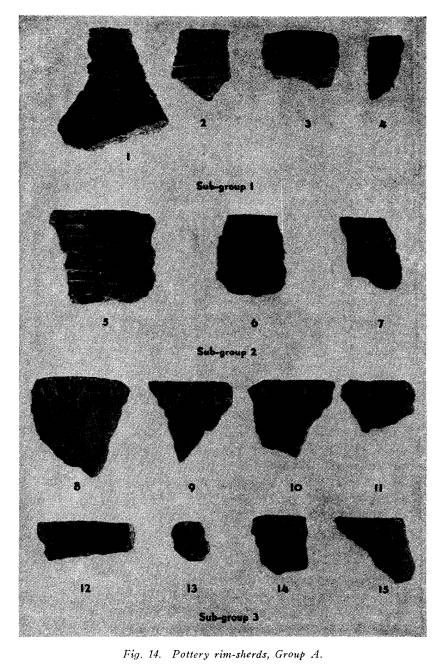
32
OHIO ARCHAEOLOGICAL AND HISTORICAL QUARTERLY
Decoration: The techniques used in the
decorating of the
pottery may be divided into two types,
impressing and incising.
The impressed designs include punctates,
notch-like impressions
and cord-wrapped stick impressions. The
incised lines are, as a
rule, wide, of medium depth, and were
apparently made with the
end of a stick or bone.
Two distinct major groups have been set
up for the pottery
from this site, Group A and Group B.
These groups have been
differentiated on the basis of texture,
size, thickness and decora-
tion. Ninety-nine percent of the sherds
fall within Group A.
Group A has been divided into the
following sub-groups on the
basis of the combination of design
elements:
Sub-group I (Fig. 14, Nos. 1-4): This
sub-group is rep-
resented by fifty-eight rim-sherds. The
design consists of notches
and incised lines, the former being
vertical or slightly oblique,
about 3.5 mm, wide, relatively deep, and
spaced 7 mm. apart along
the outer edge of the lip. The incised
lines are horizontal, five
in number, except for one sherd which
apparently has only four
(Fig. 14, No. 2), and occupy most of the
rim area. These lines
vary in width from 2.5 mm. to 3 mm. and
are of medium depth;
the bottom line usually being about 55
mm. below the lip. A
single sherd has slightly oblique,
narrow, parallel notches, 12 mm.
in length and 6 mm. apart, placed just
below the lip (Fig. 14,
No. 4).
Sub-group 2 (Fig. 14, Nos. 5-7): The
decoration of the
thirteen sherds in this sub-group
consists of a combination of
punctates and incised lines. Typical of
this division is a horizon-
tal row of circular or hemi-conical
punctate marks, 3.5 mm. to
5 mm. in diameter, spaced from 5 mm. to
10 mm. apart, and placed
approximately 5 mm. below the lip
surface. Below these punc-
tates are from two to six, broad and
medium deep, horizontal
incised lines varying in width from 2.5 mm. to 4.5 mm.
Beneath
the bottom incised line is a second row
of punctates similar to
the first, and usually impressed from
right to left. Two sherds
placed within this division lack the
horizontal row of punctates
beneath the lip (Fig. 14, No. 6). One
specimen, with two horizon-
FAIRPORT HARBOR VILLAGE SITE 33
tal incised lines, lacks the lower row
of punctates, but has the
additional feature of punctate marks on
the lip surface (Fig. 14,
No. 7).
Sub-group 3 (Fig. 14, Nos. 8-15): The
third sub-group
contains forty-three rim-sherds which
have a horizontal row of
vertical or oblique notches on an added
rim-strip. The notches
range from narrow and deep incisions to
broad and deep im-
pressions. One sherd has deep punctate
marks instead of notches
(Fig. 14, No. 9), while another has, in
addition to the features
already mentioned, punctate impressions
4 mm. in diameter on
the lip surface (Fig. 14, No. 13). On
all the specimens the rim
is bevelled between the edge of the lip
and the crest of the rim-
strip, the bevelled area ranging in
width from 10 mm. to 13 mm.
Many of the sherds in this group have
incurving rims.
Sub-group 4 (Fig. 15): One hundred and
eight rim-sherds
make up Sub-group 4. These sherds have a
row of vertical or
oblique notches on an added rim-strip.
The notches are narrow
and deep, and average 9 mm. in length.
The space between the
notches varies from 4.5 mm. to 7 mm.
Below the added rim-
strip are five wide and medium deep
horizontal incised lines, the
lines and the rim-strip occupying a
space about 50 mm. in width
from the lip surface to the bottom line.
Beneath the last line
is a horizontal row of hemi-conical
punctates made from right
to left, from 3 mm. to 3.5 mm. in
diameter and spaced from 3.5
mm. to 5 mm. apart. The only vessel
which could be partially
reconstructed falls within this group,
but it has, in addition to
the other features, small notches along
the outer edge of the lip
There is also a single sherd of this
type which may belong to the
reconstructed vessel. In addition, there
are fifty-two smaller
rim-sherds, having parallel, wide and
medium deep incised lines,
which could fall into this group or into
sub-groups 1 or 2 equally
well.
Sub-group 5 (Fig. 16, Nos. 1-9):
There are seventy-one
rim-sherds in Sub-group 5. These are
decorated with a row of
vertical or oblique notches on an added
rim-strip, the notches
as a rule being broad and deep, although
there is a considerable
|
34 OHIO ARCHAEOLOGICAL AND HISTORICAL QUARTERLY |
|
|
|
variation in their size and spacing. The bottom of the added rim- strip is, in most cases, within 20 mm. of the lip surface. There are several variants in this sub-group which may be given brief |
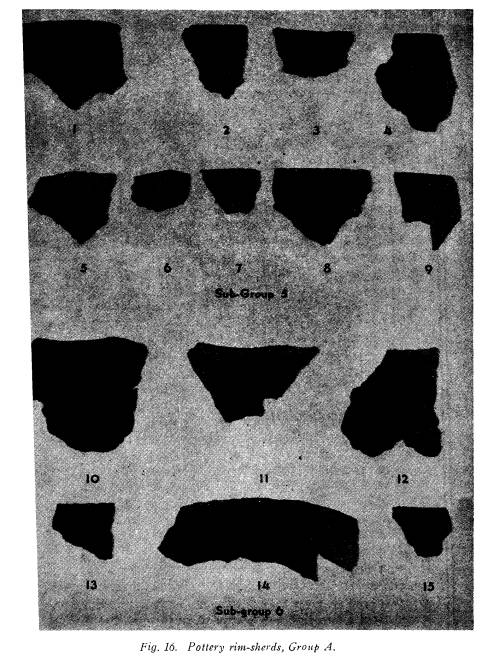
36
OHIO ARCHAEOLOGICAL AND HISTORICAL
QUARTERLY
mention: one sherd has small incisions
on the outer edge of the
lip of a raised rim (Fig. 16, No. 6);
two sherds have a row of
vertical punctate marks on the added
rim-strip, simulating the
appearance of the notches on the other
specimens (Fig. 16,
No. 8); and two sherds have small
vertical notches on the outer
edge of the lip, in addition to the
notches on the added rim-strip.
Sub-group 6 (Fig. 16, Nos. 10-15): This
sub-group con-
tains the largest number of specimens,
four hundred and forty-
nine rim-sherds in all. The decoration
consists of a row of small
to large vertical or oblique notches on
the outer edge of the lip.
These notches are, in general, less than
12 mm. apart and about
7 mm. in length. Many of the notches
appear to be dentate-stamp
impressions. Within this sub-group are
eight sherds which have
slightly raised rims, the raised portion
being notched in the same
manner as the rest of the rim (Fig. 16,
Nos. 10-11). There
are also ten additional specimens which
may be placed within
this division having narrow and deep,
vertical or oblique incisions
on the other edge of the lip, the
incisions being approximately
5.5 mm. apart (Fig. 16, No. 15).
Sub-group 7 (Fig. 17, Nos. 1-9):
The majority of the thirty-
five rim-sherds in this sub-group are
decorated on the lip surface
only, the decoration taking the form of
punctate marks, except
for a few sherds having incised notches.
Three of the sherds
have large, roughly rectangular punctate
marks, ranging from
6.5 mm. to 8 mm. in length, around the
outer edge of the lip
(Fig. 17, No. 1). Seven
sherds have hemi-conical punctates,
5 mm. to 7 mm. apart, around the lip
surface: on all but one the
marks were made from right to left.
(Fig. 17, No. 3). There are
five sherds with circular or oval
punctate impressions around
the lip surface (Fig. 17, No. 4); on
four of the sherds the punc-
tates are from 5 mm. to 6 mm. in
diameter, on the fifth 3.5
mm. in diameter; all of the impressions
are spaced from 2.5 mm.
to 4 mm. apart. Seven sherds in this
sub-group have elongated
punctate marks extending diagonally
across the lip surface (Fig.
17, No. 2); the impressions are 3 mm. to
4 mm. in width and are
spaced from 4 mm. to 8 mm. apart; all
except one have the im-
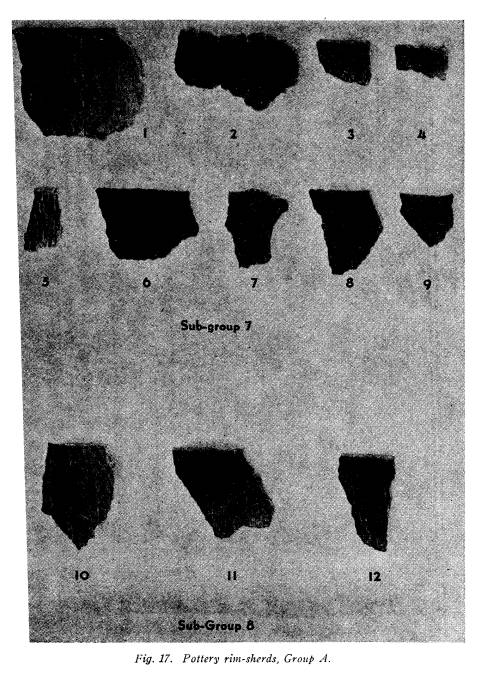
38
OHIO ARCHAEOLOGICAL AND HISTORICAL QUARTERLY
pressions slanting from the inner
surface to the right. Two sherds
have narrow, shallow punctate marks
arranged at right angles to
the edge of the lip and spaced from 4
mm. to 6 mm. apart; they
appear to have been made from right to
left; one of the specimens
has a narrow and shallow horizontal
incised line 17 mm. below
the lip (Fig. 17, No. 5). There are
eight sherds having narrow
notches or incisions on the lip surface
at right angles to the lip
edge (Fig. 17, Nos. 7-9); all of the
sherds appear to be frag-
ments of vessels with raised rims; two
of the specimens have fine,
parallel, incised lines on the rim
arranged at right angles to one
another in a sort of chevron design
(Fig. 17, No. 7); two of the
sherds have a horizontal row of
hemi-conical punctates below the
lip, spaced from 8 mm. to 9 mm. apart
(Fig. 17, No. 8). Three
sherds have small, indistinct punctate
marks around the lip sur-
face; and one of these has two narrow incised
lines on the rim
(Fig. 17, No. 9).
Sub-group 8 (Fig. 17, Nos. 10-12): This
sub-group con-
tains 78 rim-sherds which are entirely
without decoration, except
for cord-marking on the outer surface.
Miscellaneous Sherds (Fig. 18): Four rim-sherds have
broad shallow scallops on the lip
surface which are spaced about
26 mm. apart. Two of these sherds (Fig.
18, Nos. 1-2) have
small lugs which slope down from the
lip; the lugs are about
40 mm. in height and about 20 mm. in
width at the base. One
of the sherds has a perforation 5 mm. in
diameter which was
evidently used in repairing a break
(Fig. 18, N0. 3).
One of the sherds has a broken lug
beneath which are two
elongated punctate impressions (Fig. 18,
No. 16). Another sherd
has a lug which is flush with the lip;
it is 15 mm. long and is
vertically flattened. A third sherd has
a lug which is 19 mm.
in length and which has three small,
horizontal notches on its
surface. There is one fragmentary
detached loop handle which
is 20 mm. in length and 24 mm. in width;
it is decorated with
four vertical elongated punctate marks.
Another rim-sherd is
present which shows the point of
attachment for a loop handle.
Two rim-sherds have a row of small
notches on the outer
edge of the lip of a slightly flaring
and thickened rim; the thick-
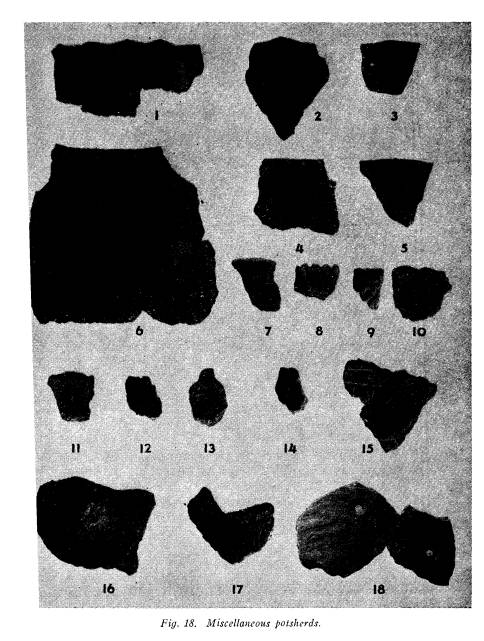
40
OHIO ARCHAEOLOGICAL AND HISTORICAL QUARTERLY
ened rim area is 10 mm. in width (Fig.
18, No. 6). Four rim-
sherds have oblique notches on the outer
edge of the lip; the
notches are wide and deep and slant from
left to right; on the
rim area of one are two horizontal
incised lines with a row of
hemi-conical punctate marks between them
which were made
from left to right (Fig. 18, No. 4). One
sherd has a row of
vertical hemi-conical punctate marks
(Fig. 18, No. 5). Another
sherd has a slight collar 9 mm. wide,
below which is a band 19
mm. in width covered with oblique
cord-marked impressions;
this band is bounded on the bottom by
two or possibly three
horizontal incised lines (Fig. 18, No.
7). There is a single rim-
sherd with small deep notches around the
edge of the lip and on
the lip surface (Fig. 18, No. 8). One
fragmentary rim-sherd
is decorated with four circular punctate
marks (Fig. 18, No. 9).
Another rim-sherd has punctate
impressions on the lip surface and
on an added rim-strip (Fig. 18, No. 10);
below the rim-strip are
oblique incised lines. One rim-sherd has
five shallow incised
lines on the outer surface (Fig. 18, No.
11); a second has three
elongated punctates giving the
appearance of vertical grooves (Fig.
18, No. 12); a third has a series of twelve
narrow incised lines
running across the surface (Fig. 18, No.
13); a fourth has a
vertical punctate mark made from bottom
to top (Fig. 18, No.
14); a fifth has two incised lines
spaced 6.5 mm. apart with a
horizontal row of vertical impressions
slightly overlapping the
bottom line (Fig. 18, No. 15); and a
sixth has a design consisting
of narrow incised lines arranged in
parallel groups of three set
obliquely (Fig. 18, No. 17).
Eight sherds in this miscellaneous
category are perforated.
The holes were drilled from the exterior
and hence have their
greatest diameter on that surface; the
diameters ranging from
6 mm. to 1O mm. Two of the sherds fit
together with the break
about midway between the two holes, the
holes being 53 mm. apart
(Fig. 18, No. 18). These holes were made
in the vessels to
repair them by binding with a thong or
cord.
Group B (Fig. 19), which seems to
be an entirely different
ware than Group A, is made up of only eleven
sherds. The
|
FAIRPORT HARBOR VILLAGE SITE 41 sherds in this group are thin, approximately 4 mm. at the lip, of fine texture, of light color, and all but one have smooth sur- faces. One specimen has a raised rim with very fine incised lines on the lip at right angles to the lip edge, and the rim is decorated with a horizontal row of inverted v-shaped figures (Fig. 19, No. 1). Another rim-sherd has small notches on the lip surface at right angles to the lip edge; just below the lip and extending down about 13 mm. are shallow, oblique, incised lines termi- nated by an indistinct horizontal line; beneath the horizontal line are several vertical lines cutting across another horizontal line (Fig. 19, No. 2). The third rim-sherd also has small notches on the lip at right angles to the lip edge; on the rim are two horizontal incised lines spaced 15 mm. apart with an oblique row |
|
|
|
of small hemi-conical punctates between the lines and indications of two other rows at right angles to the first (Fig. 19, No. 3). The fourth rim-sherd has small vertical notches on an added rim- strip; below the rim-strip are groups of three parallel incised lines extending diagonally from left to right with an interval of 37 mm. between the groups (Fig. 19, No. 4). The fifth rim- sherd has an added rim-strip with small hemi-conical punctates around it which were made from bottom to top (Fig. 19, No. 5). |
42
OHIO ARCHAEOLOGICAL AND HISTORICAL QUARTERLY
The last rim-sherd has small notches
around the outer edge of
the lip and several obscure lines on the
lower rim area (Fig. 19,
No. 6). The five bottom sherds, which
are small curved frag-
ments, range from 6 mm. to 9 mm. in
thickness (Fig. 19, Nos.
7-9). It is apparent that the sherds of
Group B are from much
smaller vessels than those of Group A.
POTTERY PIPES (Fig. 8, Nos. 8-15).
Nine fragmentary tobacco pipes, made of
baked clay, were
found at the site. All of them were
tempered with a finely crushed
grit. Only one of the pipes (Fig. 8, No.
8) was complete enough
for a determination of its original size
and shape; it is an elbow
type of pipe with a thick rounded stem
tapering toward the stem-
opening; the stem is 40 mm. in length,
the stem opening 5 mm.
in diameter, and the bowl 52 mm. high; the
stem and the portion
of the bowl below the rim are encircled
with fine, irregular,
incised lines; one side of the stem has
been flattened by
abrasion and there is a collar around
the top of the bowl extend-
ing 15 mm. down from the lip.
One of the bowls (Fig. 8, No. 13) has a
slight collar ex-
tending 14 mm. below the lip; encircling
this collar are three
medium deep incised lines spaced 3 mm.
apart; the lip is flat and
10 mm. in thickness. Another fragment of
pipe bowl (Fig. 8,
No. 12)
has a collar extending down 6 mm. below a
flat lip
which is encircled by two medium deep
incised lines; just beneath
the bottom line is a horizontal row of
short oblique incisions.
This type of incised line design is
common on pottery pipes from
New York state.5
A third fragment of a pipe bowl has a
slight collar extending
down 5 mm. below a flat lip; this bowl
is without decoration.
In addition, there are two other
fragments of pipe bowls which
are too incomplete to furnish much
information. There are three
fragments of pipe stem ranging in
greatest diameter from 10 mm.
to 19 mm. (Fig. 8, Nos. 9-11).
5A. C. Parker, "Archaeological
History of New York," part I, fig.
24, no. 3.
|
FAIRPORT HARBOR VILLAGE SITE 43 HISTORIC MATERIAL In addition to the Indian artifacts occurring at the site, a few objects were found belonging to the historic period. This material of white man's provenience includes fragments of clay tobacco pipes, a portion of a flintlock gun, a knife blade, iron nails, pieces of chinaware and stoneware, and fragments of pig teeth. Fifty-six fragments of white-clay tobacco pipes were re- covered during the course of the excavating (Fig. 20, Nos. 5-12); supplementing these are other fragments in Fairport Harbor col- lections, three of which are illustrated in Fig. 20, Nos. 5-7. The pipe fragments were found at various levels in the village deposit and from all indications may be considered as belonging to the Indian occupancy of the site. Forty-eight of the fragments are portions of stems and eight are pieces of bowls. The pipes had relatively small bowls and slender stems and were made in a two-piece mold. The three bit ends of stems in the collection |
|
|
44
OHIO ARCHAEOLOGICAL AND HISTORICAL QUARTERLY
average 5 mm. in diameter at their
terminal portions. The stems
at the bowl end are slightly flattened,
averaging (six specimens)
7 mm. in diameter on the short axis and
8 mm. on the long axis.
The length of the stems cannot be
determined as there are no
complete specimens, but they may have
been about 120 mm. in
length judging from their diameters and
degree of tapering. The
bowls were around 33 mm. in height (Fig.
20, No. 5) and per-
haps somewhat over 16 mm. in their
greatest diameter. The
thickness of the bowls at the lip is
around 2 mm. On the bot-
toms of the bowls are short tapering
spurs which project down-
ward about 5 mm. (Fig. 20, Nos. 6, 7, and 12, right). All of
the bowl fragments show some form of
decoration. The largest
fragment of bowl (Fig. 20, No. 5) is decorated with a branching
plant design with asterisks at the ends
of the branches. The
bowl shown in Fig. 20, No. 6, has on
its front surface a fluted
shield with an asterisk above it and
other asterisks around it.
The fragments illustrated by Nos. 7, 9
and II of Fig. 20 exhibit
vertical fluting only. No. 8 of Fig. 20
shows a herring-bone pat-
tern as well as fluting. The design on
No. 10, Fig. 20, may be
a floral pattern.
The portion of the iron flintlock gun
consists of the lock
plate and the pan (Fig. 20, No. 1).
The knife blade is apparently
a portion of a pocket knife (Fig. 20, No. 4). Both of
these ob-
jects are heavily rusted. While these
two specimens may date
from the Indian occupancy, the
possibility must be considered
that they may be intrusive. The three
iron nails (Fig. 20, Nos.
2-3), which are of the square type, the
fragments of chinaware
and stoneware, and the pig teeth are all
evidently relics of pioneer
times.
FAIRPORT HARBOR VILLAGE SITE 45
ANIMAL REMAINS6
By ROBERT M. GOSLIN
Animal remains were found in great
abundance at this site
scattered through the black earth of the
village deposit. They in-
clude the bones of various mammals,
fishes, birds and reptiles, as
well as the shells of mussels and
snails. Most of the bones are
in a fragmentary condition but on the
whole they are in an ex-
cellent state of preservation. All of
the animal skeletal material
was saved and carefully studied in order
to determine the number
of species which were used by the Indian
group occupying the
site. Such information not only
enlightens us as to their food
habits and the use they made of certain
bones for tools and orna-
ments, but is also of value to the
biologist in checking the occur-
rence of different species and the
changes which have taken place
in the fauna in historic times.
The total number of bone and shell
fragments recovered from
the area excavated was approximately
five thousand four hundred.
MAMMALS.
The twenty-one different species of
mammals represented will
be discussed in the order of their
abundance as indicated by the
total number of bones present for each
form.
Virginia Deer: The bones of the deer are
the most numerous
of any of the mammals found on the site.
One thousand, one
hundred and sixty specimens were
identified. We may infer from
this that the deer was the most
important single meat source for
the inhabitants of the village. The
bones of the deer were used
for the manufacture of awls, projectile
points, flint-chipping tools
and ornaments; and it may be safely
assumed that deer hides
were used for clothing and other
household purposes.
Raccoon: The raccoon is represented by
seven hundred and
ninety-four bones, among which are many
jaw and leg bones.
6The writer is indebted to the following
individuals for assistance in the identi-
fication of faunal remains: Birds, Dr.
Alexander Wetmore, Assistant Secretary,
Smithsonian Institution; Shells, Dr.
Frank C. Baker, Curator, Museum of Natural
History, University of Illinois; Fishes,
Mr. Milton B. Trautman. Assistant Curator
of Fishes, Museum of Zoology, University
of Michigan; and Dr. Carl L. Hubbs,
Curator of Fishes, Museum of Zoology,
University of Michigan.
46
OHIO ARCHAEOLOGICAL AND HISTORICAL
QUARTERLY
From the number of bones present it was
concluded that the rac-
coon was one of the most important small
game animals. Raccoon
leg-bones were made into awls, its teeth
were drilled for pendants
or beads, and penis bones of this animal
were fashioned into arti-
facts.
Elk: The bones of the elk are fairly
common as indicated by
the three hundred and twenty-four
specimens which were found.
The bones in the collection consist
primarily of leg bones, verte-
brae, antler and teeth. This mammal may
be considered as one of
the significant food animals used by the
villagers. Its teeth were
drilled for pendants, and
"gouges" and flint-chipping tools were
made from its antler. Furthermore, it
may be assumed that elk
hides were used for domestic purposes.
Beaver: The beaver is represented by
three hundred and
four specimens, which rank it next to
the raccoon among the
smaller game animals used for food.
Incisor teeth of the beaver
were made into cutting implements and
there is one jaw which
may be an ornament. The pelt of the
beaver was also undoubtedly
used for its fur.
Black Bear: The black bear ranks third
among the large game
animals in the number of bones present
with a total of two hun-
dred and eighty-five specimens. It was
an important meat source
and its hide was probably used for
robes. The canine and molar
teeth of the bear were made into
pendants, a claw was drilled for
a pendant, and penis bones were worked
into artifacts.
Gray Squirrel: One hundred and
forty-nine bones of the
gray squirrel were identified,
indicating that this species was ap-
parently abundant and evidently commonly
hunted for food.
Dog: The Indian Dog is represented by
ninety-five speci-
mens. The fragmentary bones of this
animal were found scat-
tered through the debris of the village
deposit just as were those
of the wild game animals. It cannot be
stated definitely, however,
that the flesh of this domestic animal
was used for food by the
occupants of the site. One canine tooth
was drilled for a pendant.
Porcupine: Eighty-six porcupine bones
were identified in the
collection. In addition to the use of
this animal for food, it is
FAIRPORT HARBOR VILLAGE SITE 47
probable that the quills were used for
decorating household
objects.
Wildcat: The wildcat is represented by
forty-seven bones.
Artifacts made from the bones of this
species include awls, beads,
canine tooth pendants, and worked
fragments. Since its bones
were used commonly for artifacts this
animal may have been
hunted more for this purpose than for
food.
Otter: Only eighteen bones of the otter
were found. This
mammal may have been hunted primarily
for its fur.
Gray Fox: The gray fox is represented by
twelve speci-
mens. One awl among the bone artifacts
was made from the leg
bone of a gray fox and two canine teeth
of this animal were
drilled for pendants.
Mink: Eight bones of the mink were
identified. It evidently
was not used to any appreciable extent
for food, but may have
been secured principally for its fur.
Cotton-tail Rabbit: The rabbit, judging
from the eight bones
found, was either not abundant in the
vicinity or else it was not
hunted to any great extent.
Chipmunk: The chipmunk is represented by
only seven
bones.
Woodchuck: Six bones of this species
occurred in the col-
lection.
Muskrat: Four bones of the muskrat were
identified.
Opossum: The opossum is represented by
three bones.
Meadow Mouse: The presence of the meadow
mouse, in-
dicated by three bones, may be merely
fortuitous.
Cougar: Only one fragment of a leg bone
of this large cat
was found on the site.
Fox Squirrel: The Fox Squirrel is
indicated by one lower
jaw bone. This record is of interest in
view of the fact that some
mammalogists have believed fox squirrels
to have been very rare
or absent from the region in prehistoric
times. The possibility
exists, of course, that the remains of
this species on the site could
have been introduced in later times,
although there is nothing with
reference to the specimen which would
support such an opinion.
48 OHIO ARCHAEOLOGICAL AND
HISTORICAL QUARTERLY
MAMMALS
OCCURRENCE AT VARIOUS SITES
FH R TH
SP
(No. of
bones)
Didelphis virginiana, Opossum
.............. 3
Euarctos americanus, Black Bear
............ 285 x x x
Procyon lotor, Raccoon
..................... 794 x x x
Mustela vison, Mink
........................ 8
Lutra canadensis, Otter..................... 18
Mephitis nigra, Skunk
....................... x x
Urocyon cinereoargenteus, Gray
Fox........ 12 x x
Canis familiaris, Dog
........................ 95 x x
Felis couguar, Cougar
....................... 1 x
Lynx rufus, Bobcat,
Wildcat................ 47 x x x
Marmota monax, Woodchuck
................ 6 x x
Tamias striatus, Chipmunk
................... 7 x x
Sciurus carolinensis, Gray
Squirrel........... 149 x x
Sciurus niger rufiventer, Fox
Squirrel....... 1
Castor canadensis, Beaver
................... 304 x x
x
Microtus pennsylvanicus, Meadow
Mouse..... 3
Ondatra zibethica, Muskrat
.................. 4 x
Erethizon dorsatum, Porcupine
.............. 86 x x x
Sylvilagus floridanus mearnsu, Cotton-tail
Rabbit ................................. 8 x
Cervus canadensis, Elk
...................... 324 x x x
Odocoileus virgianianus, Virginia
Deer .......1160 x x
3315
BIRDS.
Fifteen different species of birds were identified from their
skeletal remains found on the site. Altogether, one hundred and
twenty-nine bird bones were classified according to the species
represented. The list of species from the site is as follows: Com-
mon Loon, Trumpeter Swan, Canada Goose, Mallard, Blue-winged
Teal, Wood Duck, Lesser Scaup Duck, Hooded Merganser, Bald
Eagle, Wild Turkey, Herring Gull, Passenger Pigeon, Great
Horned Owl, and Snowy Owl.
The Wild Turkey stands out among the birds represented as
the most important in the economy of the Indians. Ninety-eight
bone fragments of this bird were identified. The turkey was not
FAIRPORT HARBOR
VILLAGE SITE 49
only used for food
but its bones were fashioned into artifacts.
including awls and
other worked specimens. It may be assumed
that its feathers
were used for decorative purposes.
The other birds
present are represented by from one to eight
bone fragments each,
hence, little can be said concerning their
archaeological
significance. Many beads were made from
cut and
polished sections of
leg and wing bones. These bones could not
be identified but
their different sizes indicate that a number of
different species
were utilized. It is also safe to assume that the
feathers of various
birds were used for decorative purposes.
The Passenger Pigeon,
the Herring Gull and the Snowy Owl
are here reported for
the first time from Ohio archaeological sites.
More detailed work,
however, should reveal their presence at other
sites. The Passenger
Pigeon record is of interest for this is the
only species of bird
on this list that is now extinct. In pioneer
times great flocks of
these birds were present in Ohio. The Her-
ring Gull is common
in the area today and was probably equally
so in prehistoric
times. The Snowy Owl is rare for the region
being known as an
occasional visitor from the north.
The other species of
birds, most of which are migratory, are
still found in the
area, ranging from common to rare in
their
occurrence.
BIRDS
NUMBER
OF BONES
Gavia immer, Common Loon
............................... 1
Cygnus buccinator, Trumpeter Swan ........................ 1
Branta canadensis,
Canada Goose
............................ 2
Anas
platyrhynchos, Mallard............................... 1
Querquedula
discors, Blue-winged Teal
..................... 3
Aix sponsa, Wood Duck ................................... 2
Nyroca affinis, Lesser Scaup Duck ......................... 5
Charitonetta
albeola, Buffle-head Duck
...................... 2
Lophodytes
cucullatus, Hooded Merganser
................... 1
Haliaectus
leucocephalus, Bald Eagle
........................ 2
Meleagris
gallopavo, Wild Turkey
.......................... 98
Larms argentatus, Herring Gull ............................. 1
Ectopistes
migratorius, Passenger Pigeon
.................... 8
Bubo virginianus, Great Horned Owl ....................... 1
Nyctea nyctea, Snowy Owl ................................ 1
129
50 OHIO ARCHAEOLOGICAL AND HISTORICAL
QUARTERLY
FISHES.
Fish was evidently an
important food item for the inhabitants
of the village judging
from the twelve hundred and seventy-three
fish bones found on
the site. They were secured both from the
Grand River and Lake
Erie. The bone fishhooks found on the
site reveal that the
hook and line was used and it is probable that
they also used nets
and spears. The only fish bones used for arti-
facts were the
otoliths of the Sheepshead. These were perforated
and used for pendants.
The species
identified, in the order of their abundance, are
as follows: Northern
Channel Catfish, Sheepshead, Yellow Pike-
Perch, White Bass,
Yellow Perch, and Pavement Tooth Sucker.
In addition, the
Fine-scale Sucker and the Redhorse Sucker were
tentatively
identified. Many fragments could not be identified.
FISHES
Aplodinotus
grunniens, Sheepshead, Drum Fish
Stizostedion
vitreum, Yellow Pike-Perch
Ictalurus
lacustris, Northern Channel Catfish
Lepibema chrysops, White Bass
Perca flavescens, Yellow Perch
Placopharynx
carinatus, Pavement Tooth Sucker
Catostomus or Placopharynx, Fine-scale Sucker or Pavement
Tooth
Sucker
Moxostoma or Placopharynx, Red Horse Sucker or Pavement
Tooth
Sucker
REPTILES.
The only reptile bones
found were those of the Box Turtle
and the Snapping
Turtle. The former is represented by eleven
fragments and the
latter by twelve. The Snapping Turtle was
evidently used for
food but it is doubtful if the Box Turtle was
so used. The carapace of the latter may have been
used for
containers and
rattles.
TURTLES
NUMBER OF BONES
Terrapene carolina, Box Turtle
....................... 11
Chelydra
serpentina, Snapping Turtle
................. 12
FAIRPORT
HARBOR VILLAGE SITE 51
MOLLUSKS.
The
Mollusks are represented by one hundred and fifty-three
shell
fragments. Of this number one hundred and thirty are
mussel
shells and twenty-three are snail shells. The following
species
of Freshwater Mussels were identified: Maple-Leaf,
Pimple-Back,
Mucket, Three-Ridge, Spike or Lady-Finger, Black
Sand
Shell, and Pink Heel-Splitter. All of these forms were
probably
used for food. The shells of the Maple-Leaf and Black
Sand
Shell were used for making hoes. There is also one small
disk-shaped
bead which was cut from a mollusk shell. All of the
species
represented are found in the present mollusk fauna of the
region.
Two
species of Freshwater Snails were identified for the
site,
the Green River Snail and the Slender River Snail. The
former
may have been used for food and one perforated speci-
men
of the latter was found which was probably used for a bead.
There
were also two species of Land Snails in the collection,
Polygyra
profunda and Anguispira alternata. Both
of these forms
may
have been used for food.
MOLLUSKS
FH R
TH SP
Freshwater
Mussels
Quadrula
quadrula, Maple-Leaf .................
x
Quadrula
pustulosa, Pimple-Back ..............
x
Actinonaias
carinata, Mucket ................... x
Amblema
costata, Three-Ridge
.................. x7 x7 X7
Elliptio
dilatatus, Spike, Lady-Finger
........... x7 x7 x7 x7
Ligumia
recta latissima, Black Sand
Shell....... x7
Ligwnia
nasuta ............................... x
Proptera
alata megaptera, Pink Heel-Splitter... x7 x7
Lampsilis
siliquoidea, Fat Mucket
............... x
Freshwater
Snails
Campeloma
rufum, Green River Snail........... x
Pleurocera
acuta, Slender River Snail ...........
x7
Land
Snails
Polygyra profunda ............................. x
Anquispira alternata ............................ x
7Species
made into artifacts.
52 OHIO
ARCHAEOLOGICAL AND HISTORICAL QUARTERLY
CULTURAL AFFILIATIONS
The traits present at the Fairport Harbor Site were
compared
with the traits present at the Reeve, Tuttle Hill and
South Park
village sites.
The three latter sites are the major components
making up the Whittlesey Focus of the Iroquois Aspect
which was
established by Greenman.8 Three additional components9 were
included by Greenman in the focus but these were
omitted from
this treatment because of their paucity in traits. The
traits pres-
ent at the four sites are shown in the accompanying
Comparative
Trait List (pp. 55-58).10 Pottery traits which have been omitted
from the list will be discussed separately.
The total number of individual traits present at the
four sites
is one hundred and twenty. Fifty-two of these are
universal traits
which all four sites have in common. Fairport Harbor
has ninety-
seven traits, Reeve eighty-five, Tuttle Hill
seventy-eight, and
South Park seventy-seven. A comparison of the four
sites on
the basis of the traits they have in common is given in
the fol-
lowing table.11
% in
Total Traits
Common Common
Fairport Harbor-Tuttle Hill.......... 107 68 64
Fairport Harbor-South Park......... 107 67 63
Fairport Harbor-Reeve ............... 113 69 61
Tuttle Hill-South Park.............. 92 63 68
Tuttle Hill-Reeve .................... 103 60 58
South Park-Reeve................... 97 65 67
A comparison
made by the four-cell method using the for-
mula Z=
(a--b--c+d) / (a+b+c+d)12 gives the following
results:
Tuttle South
Hill Park Reeve Fairport
Tuttle Hill.............. 1.0 .15 -- .27 -- .15
South Park............. .15 1.0 -- .06 -- .18
Reeve .................. -- .27 .06 -- 1.0 -- .30
Fairport ................ -- .15 -- .18 --
.30 -- 1.0
8Greenman, "Two Prehistoric Villages,"
348-51.
9Ibid. 357.
10The following traits were furnished by Mr. Raymond
Baby, Department of
Anatomy, Western Reserve University: South Park--beaver
incisor chisels, Os penis
of raccoon, beamers, antler gouges, and bear molar
pendants; Tuttle Hill--abrading
stones, ovoid scraper, Os penis of raccoon,
fishhooks and elk canine pendants.
11The following traits were not counted in the
statistical treatments: stone beads,
pointed-poll celts, flake knives, "turtle
backs," elk incisor pendants, and wildcat
canine pendants; historic material was also omitted
from the count.
12A. L.
Kroeber, "Statistical Classification," American Antiquity (Menasha,
Wis-
consin), VI (1940), 34.
FAIRPORT HARBOR VILLAGE SITE 53
It is evident from the two comparisons
made that these four
components are essentially alike and
that they may be placed
together in a common focus. It may be
noted that in these com-
parisons South Park and Tuttle Hill show
the highest degree of
relationship.
An analysis of the pottery from the four
sites revealed a
basic similarity. There are, however,
certain differences which
will be pointed out. All of the groups
and sub-groups present
at Fairport Harbor were present at
Reeve, although the frequency
of sherds in some of the sub-groups
varied considerably. Sub-
group 3, a very distinct type with
forty-three sherds at Fairport
Harbor, contains only four sherds at
Reeve. Sub-group 6, the
most common type at Fairport Harbor, is
present but not com-
mon at Reeve. Sub-group 7, decorated on
the lip surface, con-
tains thirty-five sherds from the
Fairport Harbor site but only
nine from Reeve. Sub-group 8,
another prominent group at
Fairport Harbor, is present but not
common at Reeve. There
are several groups of sherds from the
Reeve site which are barely
suggested or not represented at all at
Fairport Harbor. The most
prominent of these groups is that
decorated with parallel lines
at angles.13 This group at Reeve is as common as
any other
group but at Fairport Harbor it is
represented by a single sherd.
Another group, resembling Sub-group 4,
but with the addition of
elongated punctates below the added
rim-strip, is represented by
six sherds at Reeve but is not found at
Fairport Harbor. In
addition, there are several minor
variations in decoration in the
Reeve pottery which are not present in
the Fairport Harbor pot-
tery. The appendages of the pottery at
both sites are more or less
the same, consisting of small loop
handles and lugs. Group B
is represented by nine sherds at
Fairport Harbor and seven sherds
at Reeve.
Since the pottery from Tuttle Hill and
South Park is very
similar it will be discussed as a unit
in comparing it with the
material from Fairport Harbor. The
essential differences between
the sherds of these two sites and those
from Fairport Harbor lie
in a different series of combinations of
the same decorational ele-
13Greenman, "Reeve Village Site," 51.
54
OHIO ARCHAEOLOGICAL AND HISTORICAL QUARTERLY
ments. The main similarities are within
Sub-groups 3, 5, and 6.
Sub-group 5 is common in the South
Park-Tuttle Hill material
but the notches on the added rim-strip
tend to be restricted to the
lower edge of the rim-strip while those
on the Fairport Harbor
pottery extend clear across the
rim-strip. In addition, many of
the South Park-Tuttle Hill sherds have
scalloped lip surfaces as
well as plain, often both on the same
sherd. Sherds of Sub-group
6 are common at all three sites and
those of Sub-group 3 are
present at all three. Group B is
represented by only three sherds
at Tuttle Hill-South Park. Loop handles
and lugs are present
in the Tuttle Hill-South Park material
but the "knob" type of
appendage at these sites is not found at
all at Fairport Harbor.
For decorational types not present at
Fairport Harbor but occur-
ring at the other two sites the reader
is referred to Greenman's
report.14
Grit tempering predominates at all four
sites; however, at
all sites, there are also shell-tempered
sherds and sherds contain-
ing both grit and shell. Reeve
apparently has a larger percentage
of shell-tempered sherds than Fairport
Harbor, but a re-analysis
of the material might show that many of
the so-called shell-tem-
pered sherds also contain grit.
As has been indicated, the Fairport
Harbor pottery shows
a greater resemblance to the Reeve
pottery than it does to the
Tuttle Hill-South Park pottery. The main
differences exhibited
in the pottery from the four sites lie
in the varied combinations
of the same decorational techniques.
On the basis of the comparative study
that has been made
the Fairport Harbor site may be classed
as a component of the
Whittlesey Focus of the Iroquois Aspect
of the Upper Mississippi
Phase.l5
14 Greenman,
"Two Prehistoric Villages," 351-6.
15 Ibid., 348-51.
FAIRPORT HARBOR VILLAGE SITE 55
COMPARATIVE TRAIT LIST
LOCATION AND STRUCTURES
R SP TH FH
On bluff........................................ x x x
Village site over long period, black soil.............
x x x
x
Post holes indicating stockade ......................
Walls indicating fortified enclosures ................ x
Refuse and storage
pits ............................ x x
x
Burials found ...................................... x x x
Ash beds present ............................... x x
STONE ARTIFACTS
Abrading
stones ................................. x x x
A dzes ........................................ x x x x
Beads ........................................ x
Blades, unnotched .................................. x x x
Elliptical ......................................x x x
Leaf-shaped
..............................x x x
Ends pointed...............................
x x
Ends rounded .............................. x x x
Lanceolate ................................... x x
Celts .......................................... x x x x
Ground or pecked............................. x x x x
P ointed poll
............................... x
Flat or rounded poll ....................... x x x
Chipped ...................................... x x x
Slate .....................................
x x x x
Diorite spalls
............................. x x
Notched or grooved
............................ x x
Chisels .................................... x x x
Disks, roughly chipped
slate ........................ x x
Drills ........................................ x x x x
Straight
...................................... x x x x
Expanded base................................. x x x x
Flake
knives....................................... x
Fossils .......................................... x x
Gorgets
.......................................... x x x x
Hammerstones
.................................... x x x
Spherical, faceted ............................ x x x x
Pitted, asymmetrical .......................... x x x x
Incised designs on stone ........................... x x
Mortar, shallow ................................... x
Net sinkers, notched ............................... x x
x x
Pendants ......................................... x x
56 OHIO
ARCHAEOLOGICAL AND HISTORICAL QUARTERLY
R SP TH FH
Pestles, rough, bell-shaped .......................... x x
Pipes ......................................... x x x x
Effigy
........................................ x x
Conoidal ...................................... x x x
K eeled ....................................... x x
Elbow ....................................... x x x
Projectile points.................................. x x x x
Triangular, unnotched.......................... x x x x
Notched ..................................... x x x
Scrapers ......................................... x x x
Circular ...................................... x x x
Ovoid ........................................ x x x
Rectangular .................................. x x x
Triangular .................................... x x x
BONE ARTIFACTS
Awls ............................................. x x
Bird bone (leg and wing) ...................... x x x x
Unnotched ................................ x x x
N otched .................................. x x
One articular end unmodified ............... x x x
Split ..................................... x x x x
Animal bone .................................. x x x x
Cross-section
round........................ x x x x
P la in ................................. x
Incised ............................... x
Long, slender, curved antler........... x x x x
Knobbed base ..................... x x
Pointed at both ends
................... x
Flat in cross-section
........................ x x x
Plain ................................. x x
Effigy .................................x x
Expanded head or spatulate ............. x x
Pointed at both
ends................... x
Deer dewclaw ............................ x
Scapula ................................... x
Two-tined ................................ x
Beads
......................................... x x x x
Bird bones .................................... x x x x
Notched ................................. x x x
Unnotched ................................ x x x x
Animal bones .................................. x x
Beamers, deer leg-bone .......................... x x
FAIRPORT HARBOR VILLAGE SITE 57
R SP TH FH
Bones, deer phalanges, hollow ...................... x x
Bones, bird leg, incised cross-hatch .................. x
Bones, animal ribs, notched ........................ x
Bones, os penis of raccoon, polished
................. x x x x
Bones, os penis of black bear, polished
.............. x
Bones, bird scapula, polished ....................... x
Bones, worked human skull fragment................ x
Chipping tools
..................................... x x x x
Antler, cylindrical, ends blunt ................... x x x x
A ntler tine .................................... x x x
Os penis raccoon
............................... x x x x
Chisels, antler
..................................... x
Chisels, beaver
incisor .............................. x x
x x
Combs
........................................ x
Fish-hooks
........................................ x x x
Unbarbed, shaft round.......................... x x
Knobbed end.............................. x
Unknobbed end............................ x x
Unbarbed, shaft flat ........................... x x
Flutes,
bird bone
................................... x x x
Gouges, antler ..................................... x x x
x
Handles, antler tine, socketed ...................... x
Jaws, animal, worked .............................. x
Musical rasps, bone ................................ x x
N eedles ........................................... x
Pendants ........................................ x x x x
Teeth
........................................ x x x x
Bear canine, perforated ..................... x x x
Bear molar, perforated ..................... x x
Elk canines, perforated ..................... x x x x
Elk
incisor, perforated
..................... x
Wildcat canines, perforated ................ x
Small animal, perforated .................... x x
Bear
claws, perforated
......................... x
Turtle leg-bone, perforated ..................... x
Flat, thin, rectangular, perforated.............. x
Projectile points, antler, socketed ..................
x x x x
Projectile points, flat, concave base.................. x
Punches, large
.....................................
x x x x
SHELL ARTIFACTS
Bead,
disc, flat..................................... x
Hoes, mussel shell .................................. x x x x
M ussel shell, edge
ground .......................... x x x
Pendant,
perforated ................................ x
58
OHIO ARCHAEOLOGICAL AND HISTORICAL QUARTERLY
R SP TH FH
COPPER ARTIFACTS
Beads,
tubular ..................................... x x
TRADE OBJECTS
Miscellaneous material .......... .. ..........x.
CONCLUSIONS
The Fairport Harbor Village site is one
of a number of sim-
ilar sites located on the south shore of
Lake Erie. Culturally it
is closely related to the Reeve, Tuttle
Hill and South Park vil-
lage sites as well as other sites in the
area. The four sites are
located on major streams and are
characterized by thick deposits
of black earth resulting from long
occupation. Implements, orna-
ments, potsherds and animal bones are
found scattered through
the black earth and also in storage or
refuse pits. Burials were
made in the village area at South Park,
Tuttle Hill and Reeve,
but no burials were found at Fairport
Harbor. No structural
features were recognized at any of these
sites which would indi-
cate the type of houses used by the
inhabitants. Several series of
post-molds at Fairport Harbor may be
interpreted, with a rea-
sonable degree of certainty, as remnants
of stockades which once
enclosed the village area.
No evidence of stockades was found at
the other three sites,
but according to Whittlesey, the village
area at Tuttle Hill, which
occupied a promontory, was originally
set off by two parallel
earthen walls with outer ditches.l6 It is probable that Reeve
and South Park were also enclosed by
stockades or palisades.
In the same region are hill-top
fortifications characterized by one
or more parallel earthen walls.l7 Some of these have been corre-
lated with the same people responsible
for the village sites under
discussion. Since the ones examined
revealed little evidence of
occupation it is likely that they served
as places of defense rather
than occupation sites.
16 C. C. Whittlesey, "Ancient Earth
Forts of the Cuyahoga Valley, Ohio,"
Western Reserve and Northern Ohio
Historical Society, Tracts (Cleveland), no.5
(1871), 11.
17 E. F. Greenman, "Seven
Prehistoric Sites in Northern Ohio," O. S. A. H.
Quart., XLIV (1935), 220-7.
FAIRPORT HARBOR VILLAGE SITE 59
Sites of the Whittlesey Focus have been
attributed to the
Erie Indians by some writers because the
Erie are known to have
lived in the area and due to the
similarity of the remains to
Iroquoian remains in the East.18 In
the Jesuit Relations of
1647-48 it is recorded that the Erie
lived along the southern
shores of Lake Erie, that they tilled
the soil, and that they spoke
the same language as the Huron.l9 Available evidence indi-
cates that the Erie were,
linguistically, an Iroquoian people.20
It is also recorded that the Erie made
use of palisades.21 While
there is no direct evidence that the
Erie were the occupants of
the various sites of the Whittlesey
Focus, the archaeological
material and the historical records seem
to bear out that con-
clusion. Greenman has pointed out the
similarities between the
northern Ohio sites and the Ripley site
of New York which
Parker assigned to the Erie.22
In attempting to establish the time of
occupation of the Fair-
port Harbor site there are several
factors to be considered. In
the first place, the historic material
found in the site must be
evaluated. The clay tobacco pipes,
judging from the number
of fragments and their distribution in
the site, are assumed to
belong to the period of occupancy. The
gun fragment and the
knife blade may or may not belong to the
Indian occupation.
Clay tobacco pipes were common articles
of trade and were
among the first objects to be introduced
by the white man.
According to McGuire, clay pipes
decorated with shields and
branches of the tobacco plant were
apparently made in England
at the beginning of the seventeenth
century.23
If one attributes the site to the Erie,
the probabilities are
that it was occupied before the middle
of the seventeenth cen-
tury for the Erie are reported to have
been defeated and their
18 H. C. Shetrone, The Mound Builders (New York, 1931), 277-8;
Greenman,
"Reeve Village Site," 9.
19 Reuben Gold Thwaites, ed., Jesuit Relations and Allied Documents (Cleveland,
1896-1901), XXXIII, 63.
20 A.
C. Parker, "Excavations in an Erie Indian Village and Burial Site at
Ripley,
Chautauqua Co., N. Y.," New York
State Museum Bulletin (Albany, N. Y.), no. 117
(1907), 528.
21 Jesuit Relations, XLII, 179,
181.
22 Greenman, "Two Prehistoric
Villages," 350.
23 J. D. McGuire, "Pipes and
Smoking Customs of the American Aborigines,
Based on Material in the U. S. National
Museum," U. S. National Museum Report,
1897
(Washington, D. C.), part I (1899), 452-3.
60
OHIO ARCHAEOLOGICAL AND HISTORICAL QUARTERLY
villages destroyed by the Iroquois in
1654.24 The scarcity of
trade material at the site also favors
this conclusion, for if the
site was later, one would expect more
trade objects and a greater
variety of types. In their earlier
conflicts with the Iroquois the
Erie did not have fire-arms,25 but
by the time of their final
defeat they apparently had acquired a
few guns.26 Hence, the
rifle at the site could have belonged to
the inhabitants and need
not be attributed necessarily to a later
period. No historic ma-
terial has been reported found at other
sites of the Whittlesey
Focus. This fact would also support the
idea that the Fairport
Harbor site was occupied early in the
seventeenth century. In
this connection it should be noted that
at the South Park site
a pottery vessel was found that has been
termed a trade piece
from
the Oneota culture of Iowa and adjacent states.27 The
Oneota Aspect has been attributed by
Griffin to the Chiwere
Sioux who are known to have lived in
that area in the seven-
teenth century.28 Historic trade material has also been
found
with this culture in Iowa. In other
words, both of these cultures
were transitional from the prehistoric
to the historic period.
In summary, the Fairport Harbor site has
been classified as
a component of the Whittlesey Focus of
the Iroquois Aspect of the
Upper Mississippi Phase. The occupants
of the site are thought
to have been members of the Erie tribe,
a group related to the
Iroquois peoples of New York. The
village was probably estab-
lished toward the close of the sixteenth
century and perhaps oc-
cupied up to the middle of the
seventeenth century.
In studying the Iroquois culture, as it
is represented in Ohio
by the Whittlesey Focus, it is well to
see it in relation to the
other archaeological cultures which have
been recognized for
the Ohio area. The relations to be
considered are those of cul-
tural connection, chronological position
and geographical dis-
tribution. In presenting this
generalized outline no attempt is
24 Jesuit Relations, XLII,
177-83.
25 Ibid., XLI, 83.
26 Ibid., XLII, 181.
27 Greenman, "Two Prehistoric
Villages," 346.
28 J. B. Griffin, "The
Archaeological Remains of the Chiwere Sioux." American
Antiquity, II, no. 3 (1937), 180-1.
FAIRPORT HARBOR VILLAGE SITE 61
made to present all the evidence which
has been considered in
arriving at the various
conclusions. The interpretations seem
to be the most logical ones on the basis
of the present evidence
and are subject to revision as new facts
come to light.
The more recent cultures will be
considered first--those
which bridge the gap between prehistoric
and historic times. The
year 1600 A. D. has been chosen
arbitrarily as marking the be-
ginning of historic times. Two cultures
have been established
as extending up into the historic
period, the Iroquois and the
Fort Ancient. The evidence concerning the Iroquois (Erie)
has already been discussed. The remains
of the Fort Ancient
peoples are found distributed through
southern Ohio and portions
of the adjacent states. The material comes largely from village
sites and burial grounds. Culturally, the material traits of this
group show a basic resemblance to those
of the Iroquois, hence
these two cultures have been placed
together in a larger division
known as the Upper Mississippi Phase.29
The Fort Ancient peo-
ples were evidently contemporaneous, at
least in part, with the
Iroquois, for trade objects secured from
the white man have
been found at several of their sites.30
The length of time these
two cultures existed as distinct
entities cannot be determined,
but they must have been functioning
through most of the six-
teenth century.
Leaving behind the Iroquois and the Fort
Ancient cultures,
which are transitional from prehistoric
to historic times, and
entering the purely prehistoric period,
the chronological prob-
lems become more difficult. The time
sequence that has been set
up for the older cultures is entirely
relative. It is not known
how far back the oldest of these
cultures began or how close to
the historic period the youngest of
them existed. Hence, the
chronology is not only relative but the
total amount of elapsed
time is also unknown. The time sequence
is based on stratigraph-
29 J. B. Griffin, in National Research Council, Division of
Anthropology and
Psychology, Committee on State
Archaeological Surveys, The Indianapolis Archaeo-
logical Conference (Washington), 1935, p. 48.
30 E. A. Hooton and C. C. Willoughby, "Indian Village Site and
Cemetery near
Madisonville, Ohio," Peabody Museum
of American Archaeology and Ethnology, Har-
vard University, Papers (Cambridge),
VIII, no. 1 (1920), 135. Reported also from a
Kentucky site.
62
OHIO ARCHEOLOGICAL AND HISTORICAL QUARTERLY
ical and typological evidence that has
been discovered in Ohio and
other areas. There are four cultures in
Ohio which are com-
pletely prehistoric, i. e., no
evidence has come to light showing
that the peoples of these groups had any
contact with the culture
of the white man. These cultures, known
as "Intrusive Mound,"
Hopewell, Adena, and "Gravel
Kame," had apparently reached
their climax and had passed out of
existence as functioning units
before the discovery of the New World.
The "Intrusive Mound" culture
is represented by several
mounds in Scioto County and by burials
and artifacts intrusive in
mounds of the Hopewell culture at Mound
City in Ross County.31
Culturally, it is apparently the equivalent
of the Point Peninsula
culture of New York.32 Since
burials of this culture were found
intrusive in Hopewell mounds it is
considered to be post-Hope-
wellian in age.
The Hopewell culture is known from many
sites distributed
throughout the Mississippi Valley and
its tributaries, but one of
its most important centers is located in
southern Ohio. The
peoples of this culture were good
craftsmen and made fine tools
and ornaments. They possessed an
elaborate burial cult which in-
cluded the building of complicated
earthworks and mounds and
the practice of placing large ceremonial
offerings with their bur-
ials. Many of the Hopewell sites in Ohio
were contemporaneous
with sites of the same culture in the
Illinois River Valley and of
certain other areas.33 Likewise the Copena culture of
Alabama
and Tennessee evidently dates from the
same time period.34
Certain Copena-type artifacts,
apparently representing trade pieces,
have been found in Ohio sites.35 As
has been indicated, the Hope-
well culture antedates the
"Intrusive Mound" culture.
31 W. C. Mills, "Exploration of the
Mound City Group," O. S. A. H. Quart.,
XXXI (1922), 563-84.
32 W. A. Ritchie, "Culture Influences from Ohio in New
York Archaeology,"
American Antiquity, II, no. 3 (1937), 188-93. See also, "A Perspective of North-
eastern Archaeology," ibid., IV,
no. 2 (1938), 100-2.
33 J. B. Griffin and R. G. Morgan, eds.,
"Contributions to the Archaeology of
the Illinois River Valley,"
American Philosophical Society, Transactions (Philadel-
phia), New Series, XXXII, part I (1941),
47-9.
34 W. S. Webb, "An Archaeological Survey of Wheeler Basin on the
Tennessee
River in Northern Alabama,"
Smithsonian Institution, Bureau of American Ethnology,
Bulletin (Washington),
no. 122 (1939), 188-99.
35 H. C. Shetrone and E. F.
Greenman, "Exploration of the Seip Group of Pre-
historic Earthworks," O. S. A.
H. Quart. XL (1931), 416-24.
FAIRPORT HARBOR VILLAGE SITE 63
The Adena culture is represented by many
mounds in the
southern half of the State. Mounds of
this culture are present
in greater abundance than those of any
other. Adena mounds
are also common in Indiana, Kentucky and
West Virginia. It
has been recognized that almost all of
the Adena traits have their
counterparts in the Hopewell culture.36
Furthermore, Hope-
wellian-type artifacts have been found
in some of the Adena
mounds of Kentucky.37 Evidence
of this nature has supported
the view that the Adena culture may have
preceded the Hopewell
culture and that it may have evolved
into the Hopewell culture.38
In any case, it is apparent that they
are definitely related to each
other and that they belong to the same
general time period.
The "Gravel Kame" culture is
known from burials in gravel
deposits in northwestern Ohio, southern
Michigan and north-
eastern Indiana. The culture has not
been well-defined but there
is a recurring complex including such
objects as mocassin-shaped
shell gorgets, circular shell gorgets,
shell beads, birdstones and
massive copper beads.39 Chronological
evidence is almost en-
tirely lacking but on typological
grounds the "Gravel Kame"
culture has been placed tentatively in
the general Adena-Hope-
well time period.
In addition to these four prehistoric
cultures which have
been definitely delineated, there
remains a large mass of archaeo-
logical material which has not been
classified culturally. In the
main, the material in this category
consists of surface finds,
although some of it is from the
rock-shelters of eastern Ohio. The
rock-shelter material does not represent
a distinct cultural unit
for it is evident that the shelters were
occupied at various times
by different groups. A part of the
shelter material can be as-
signed to several of the established
cultures.
There are hundreds of specimens in Ohio
collections which
fall into the so-called Bannerstone
class. This type of material
is usually thought to belong to an early
Woodland horizon. Some
38 E. F. Greenman, "Excavation of
the Coon Mound and an Analysis of the
Adena Culture," loc. cit. XLI
(1932), 493.
37 W. S. Webb, "The Wright
Mounds," University of Kentucky, Reports in An.
thropology (Lexington), V, no. 1 (1940), 53-74.
38 Greenman, "Excavation of the
Coon Mound," 487-502.
39 Field Notes, Department of
Archaeology, Ohio State Museum.
64
OHIO ARCHAEOLOGICAL AND HISTORICAL
QUARTERLY
of it may belong to the Adena-Hopewell
time period but it is
probable that part of it may date from
still earlier times. The
fluted-blades or Folsom-like points
found in Ohio may be very
old, but it has not been demonstrated
that they tie in with the
Folsom culture of the High Plains. No
evidence is available to
classify the fluted-blades either
culturally or chronologically.40
Archaeological explorations in the Ohio
area over a period
of years have added much to the
archaeologist's knowledge of
the prehistoric Indian groups of the
region. A number of dis-
tinct cultures have been recognized and
characterized and a gen-
eral time sequence has been established
for them. Investigations
in other areas have shown that some of
these cultures had a wide
distribution. It is now possible for the
archaeologist to make
larger comparisons and to view the Ohio
cultures in relation
to the general prehistory of the eastern
portion of the United
States.
40 H. C. Shetrone, "The Folsom
Phenomena as Seen from Ohio," O. S. A. H.
Quart., XLV
(1936), 240-56.

